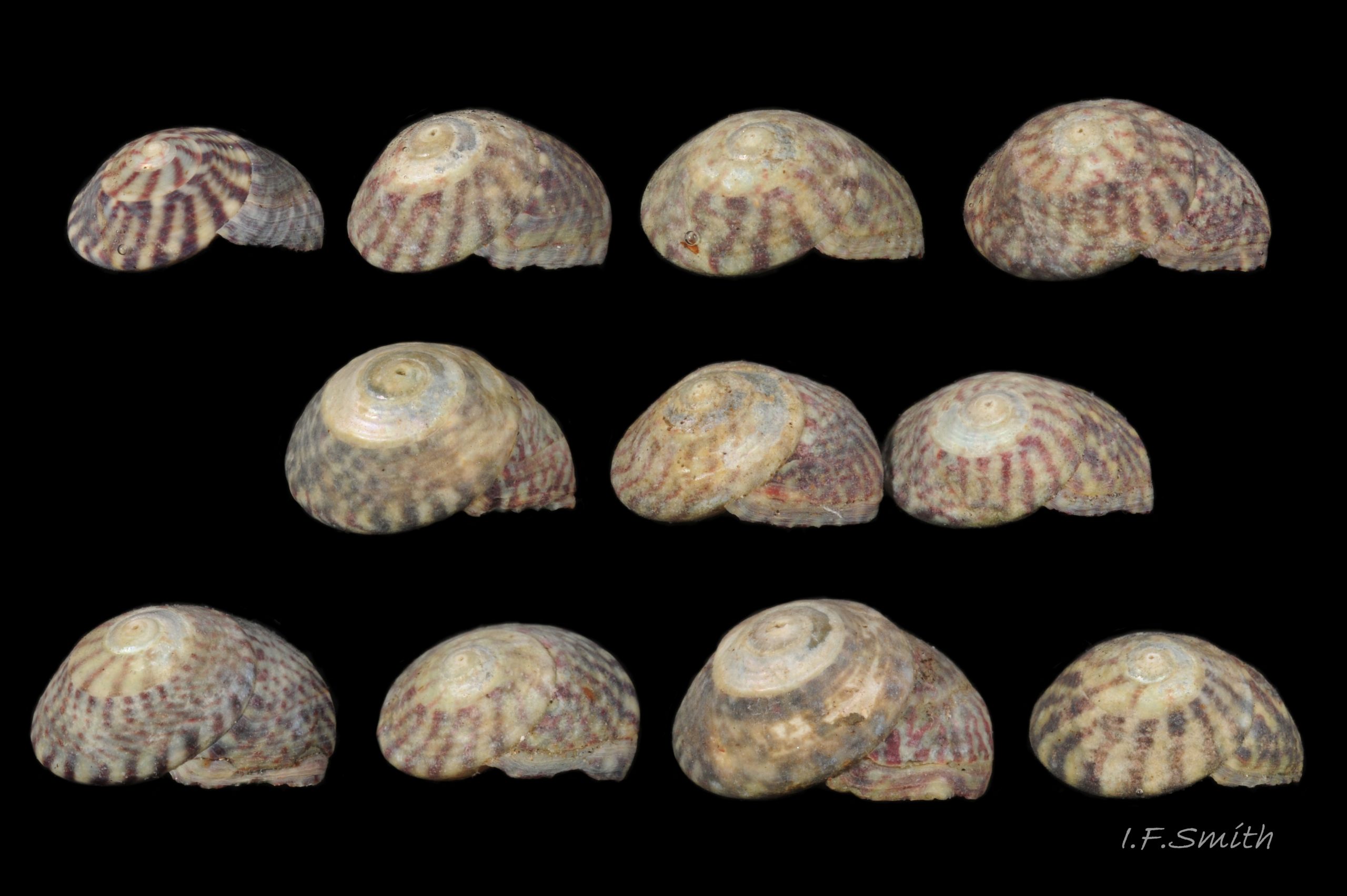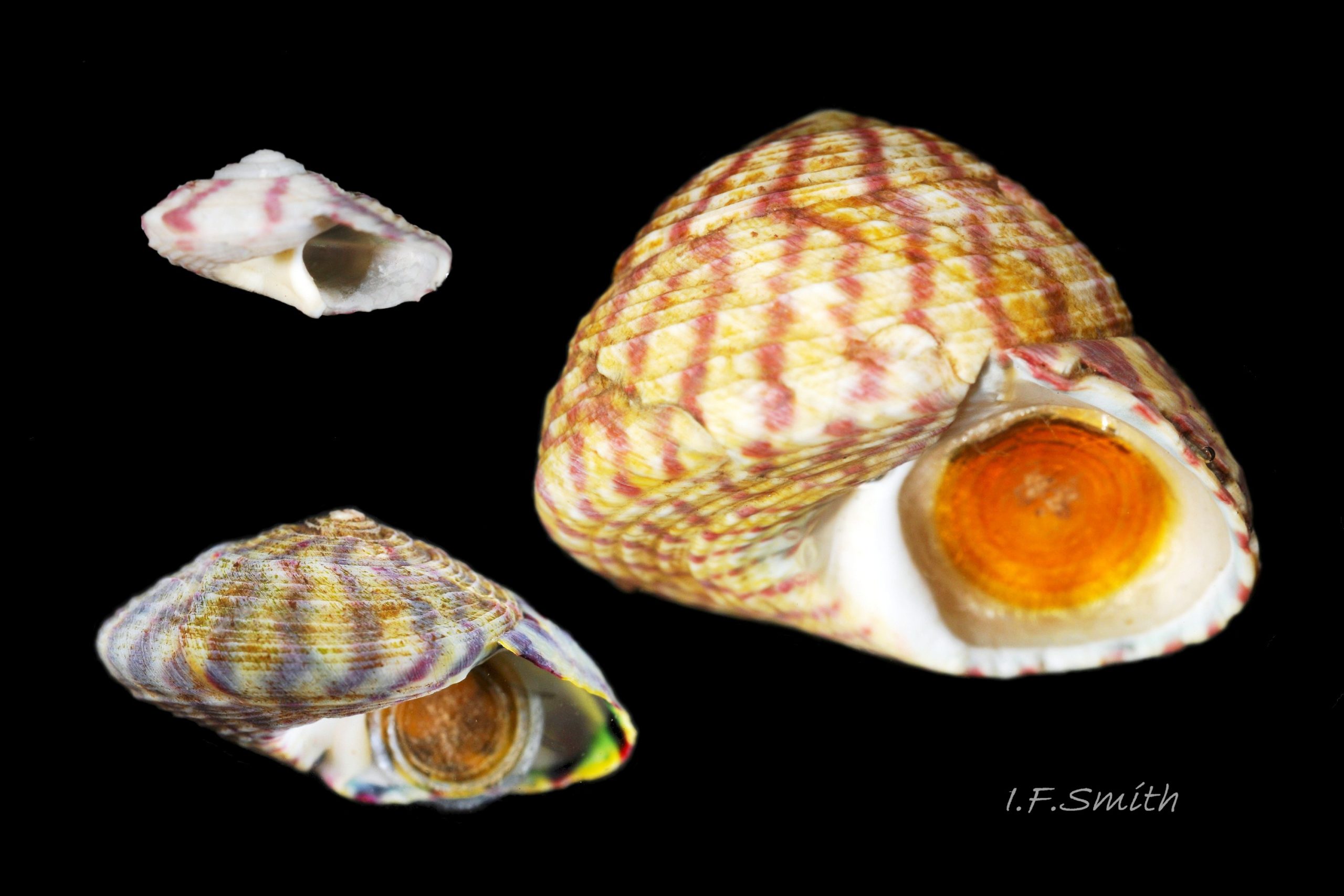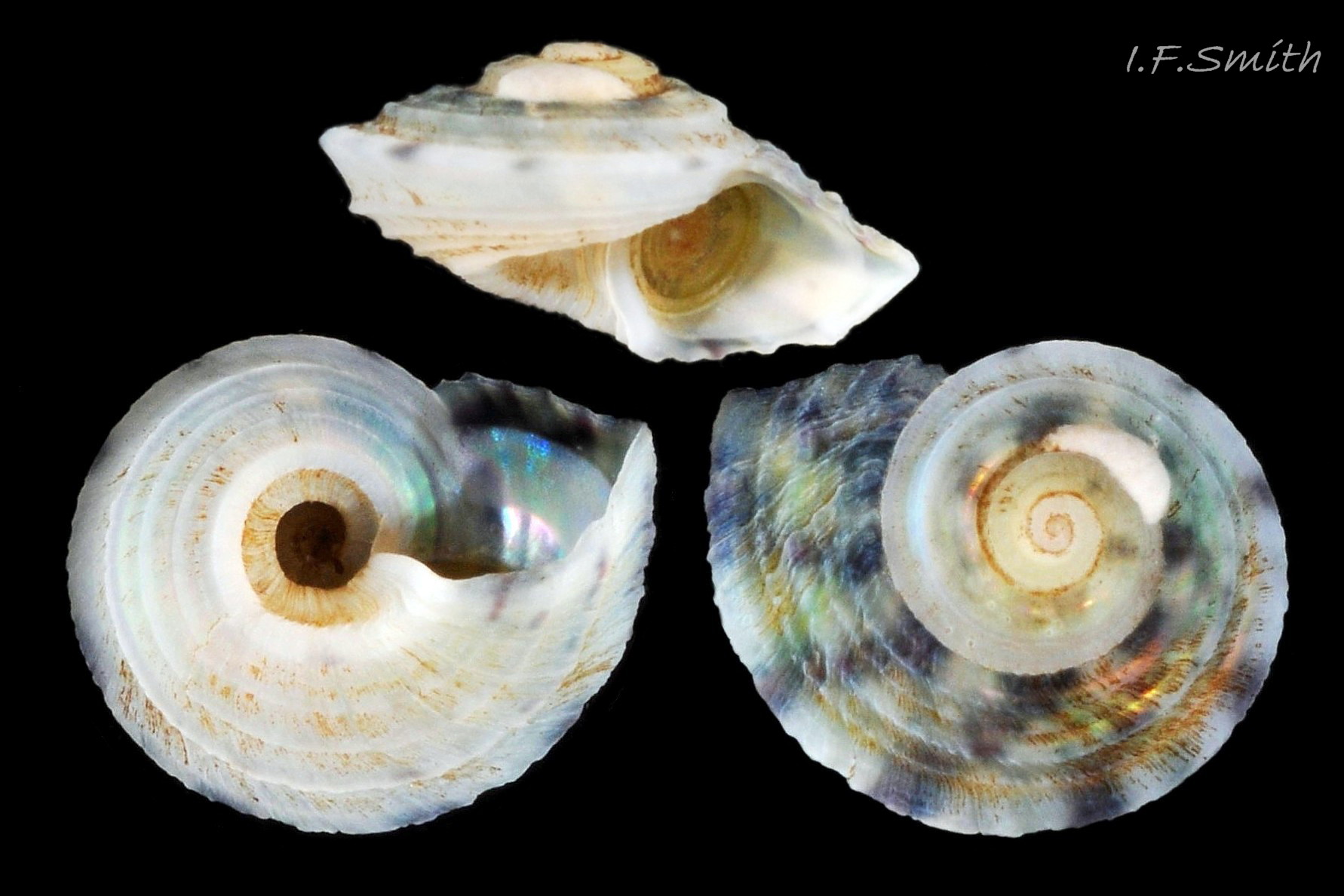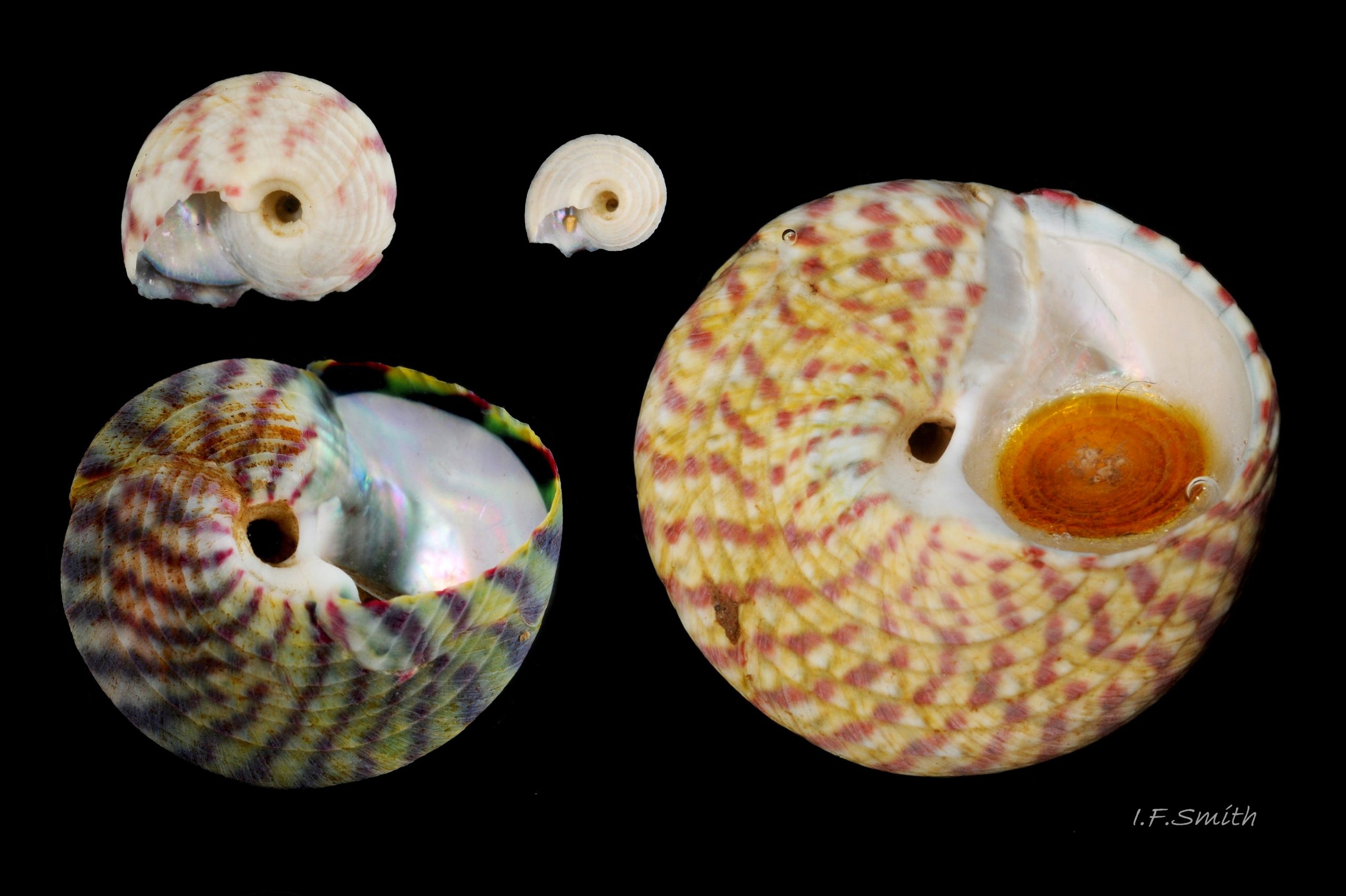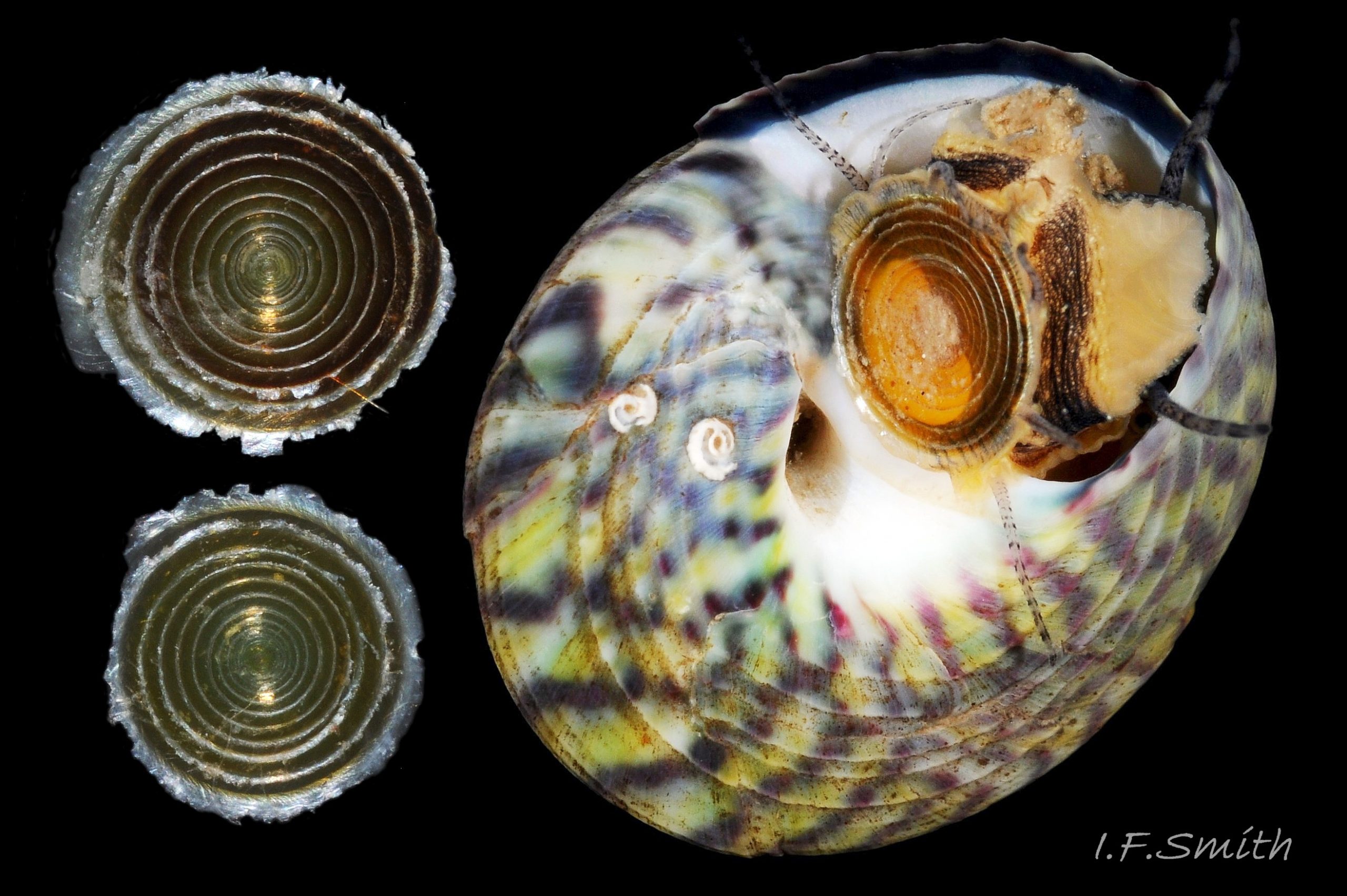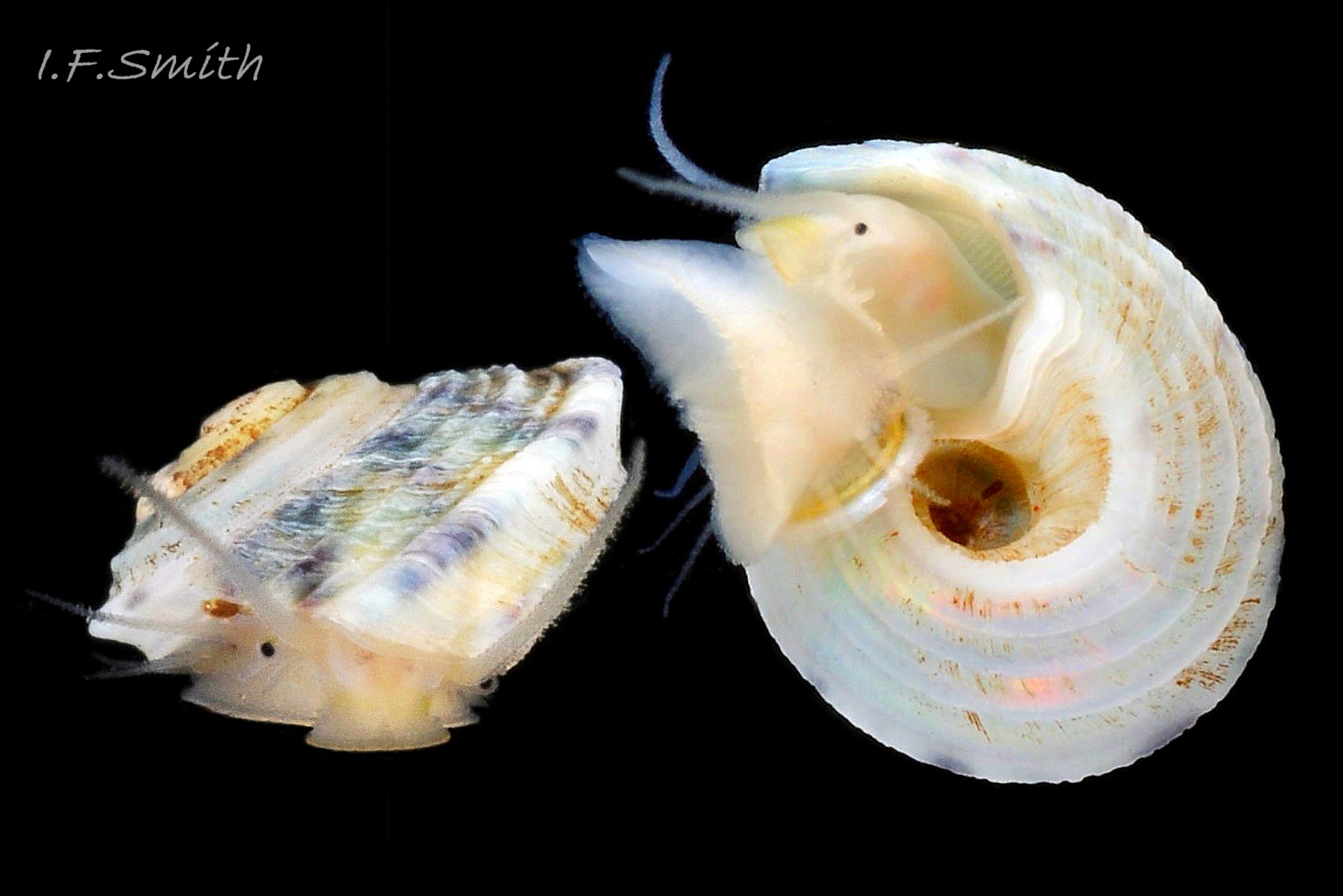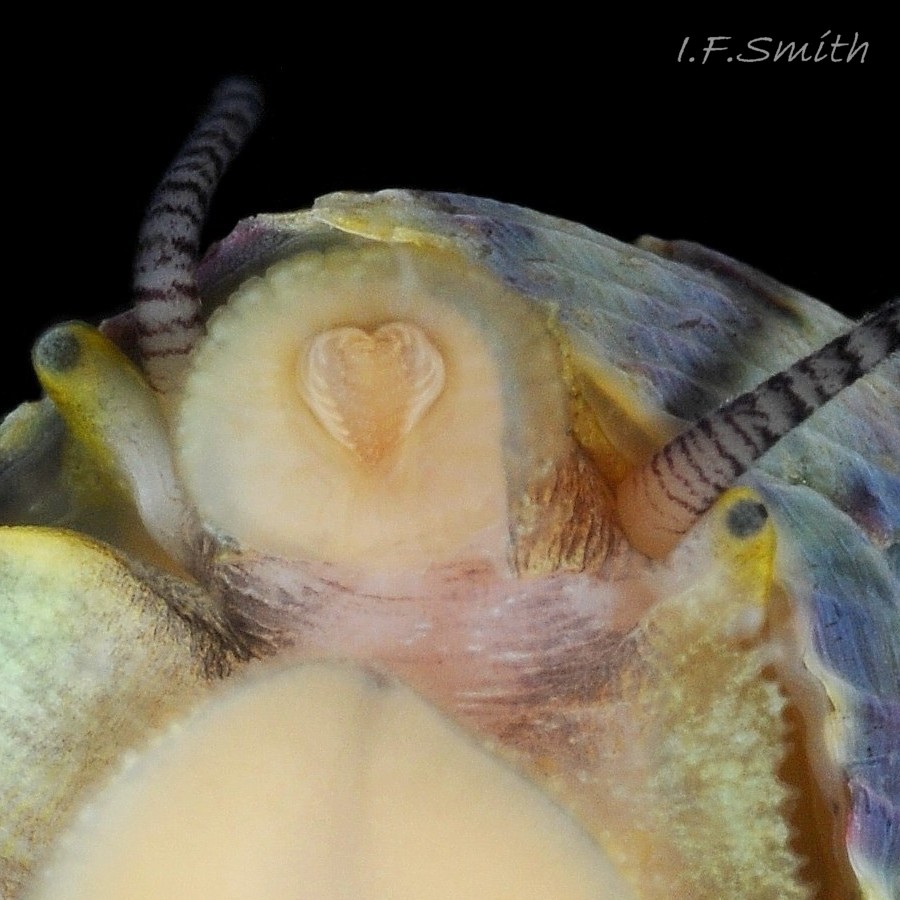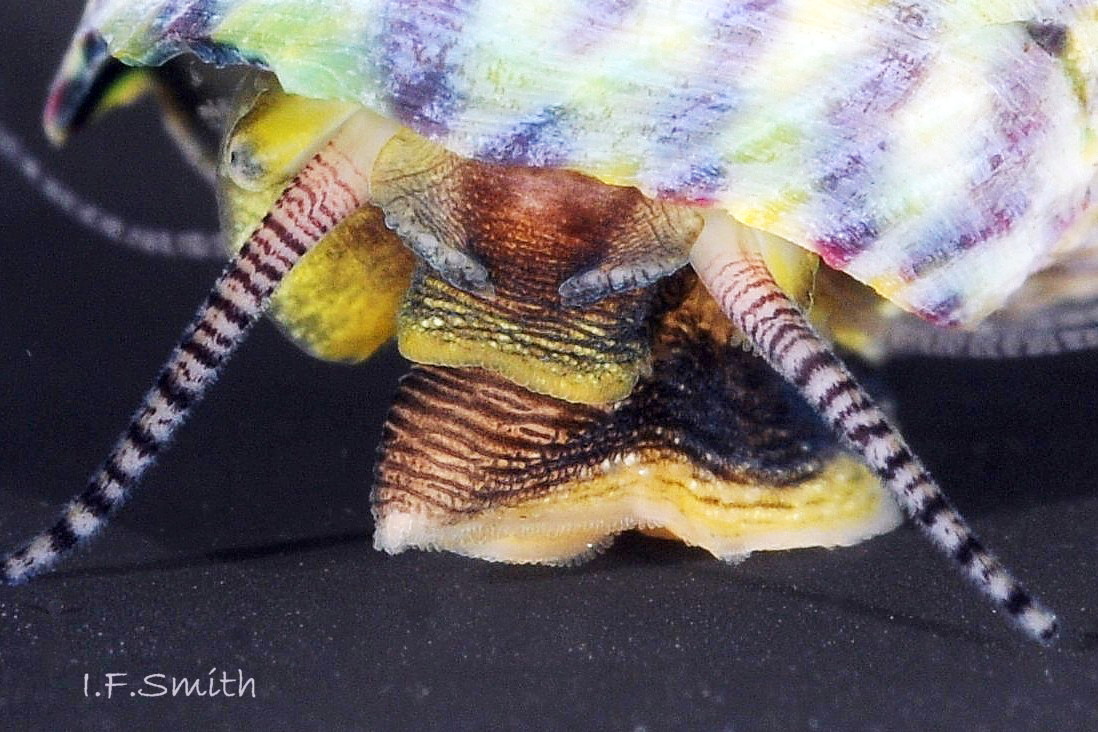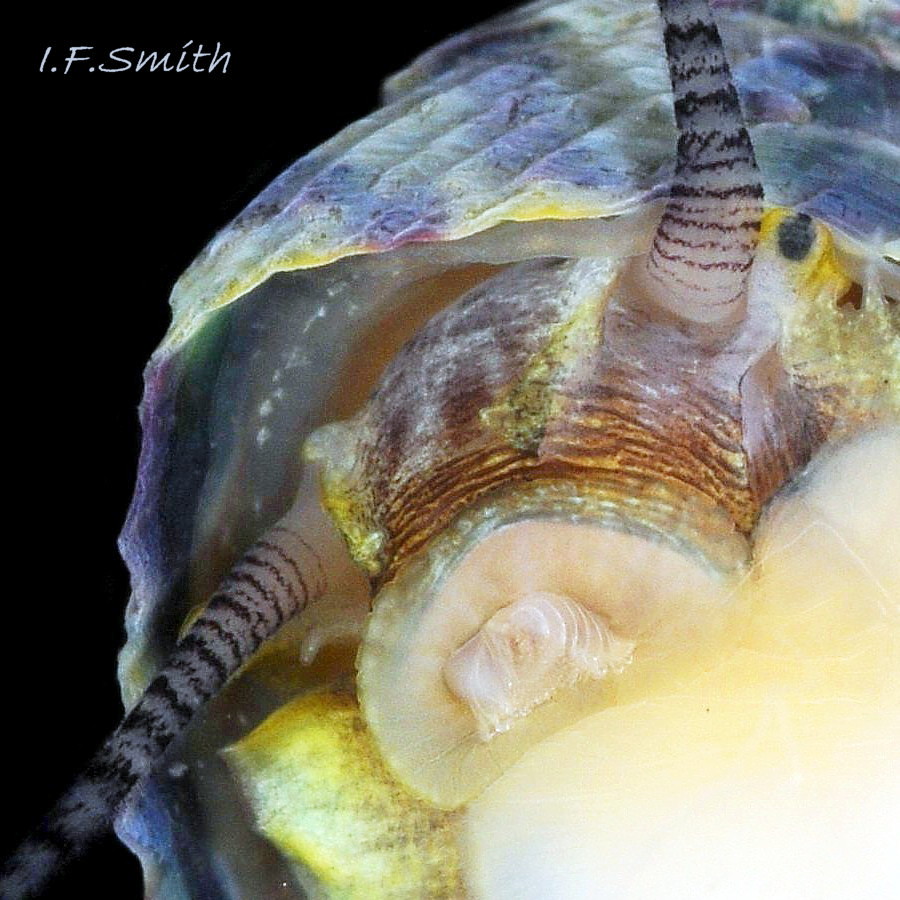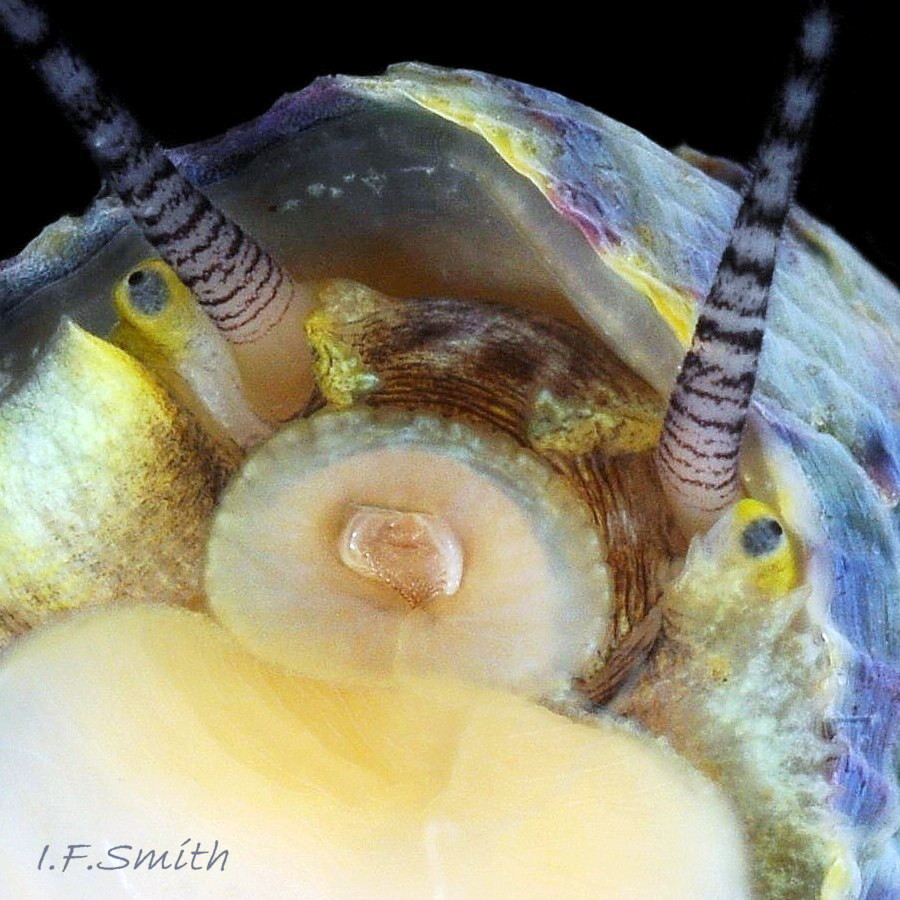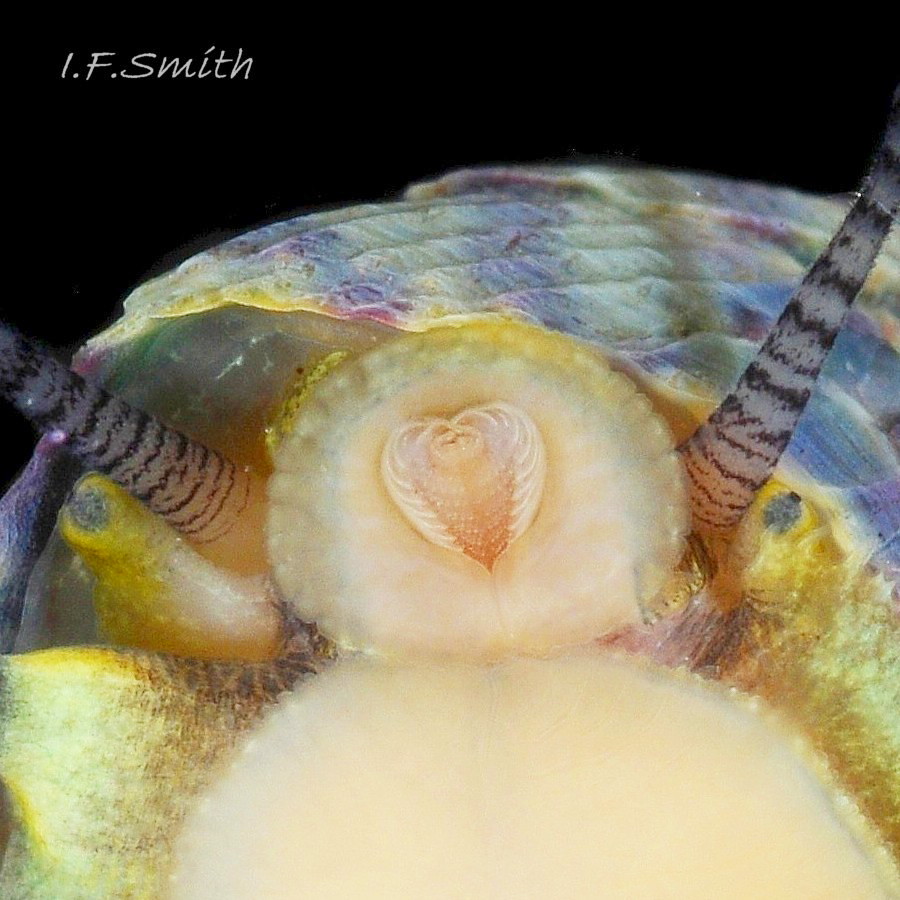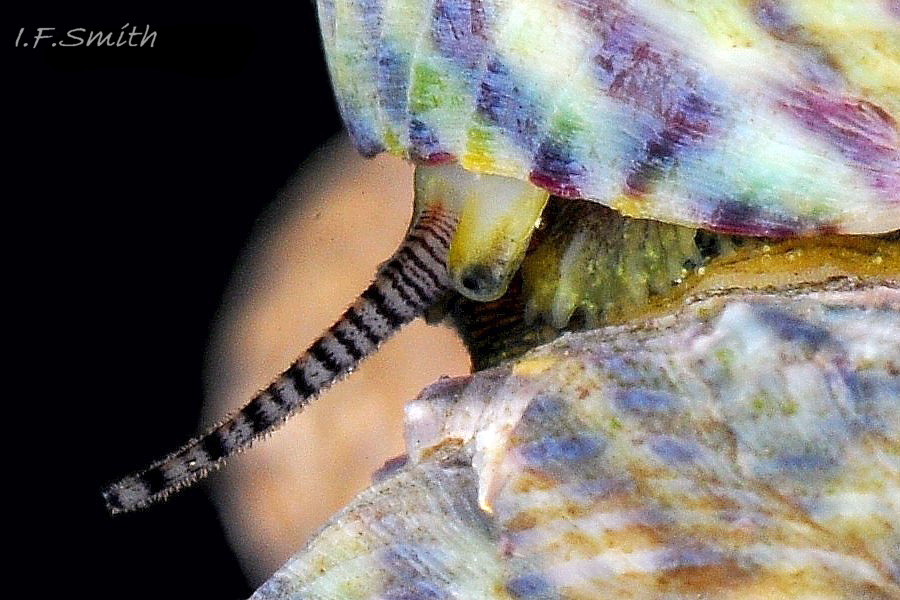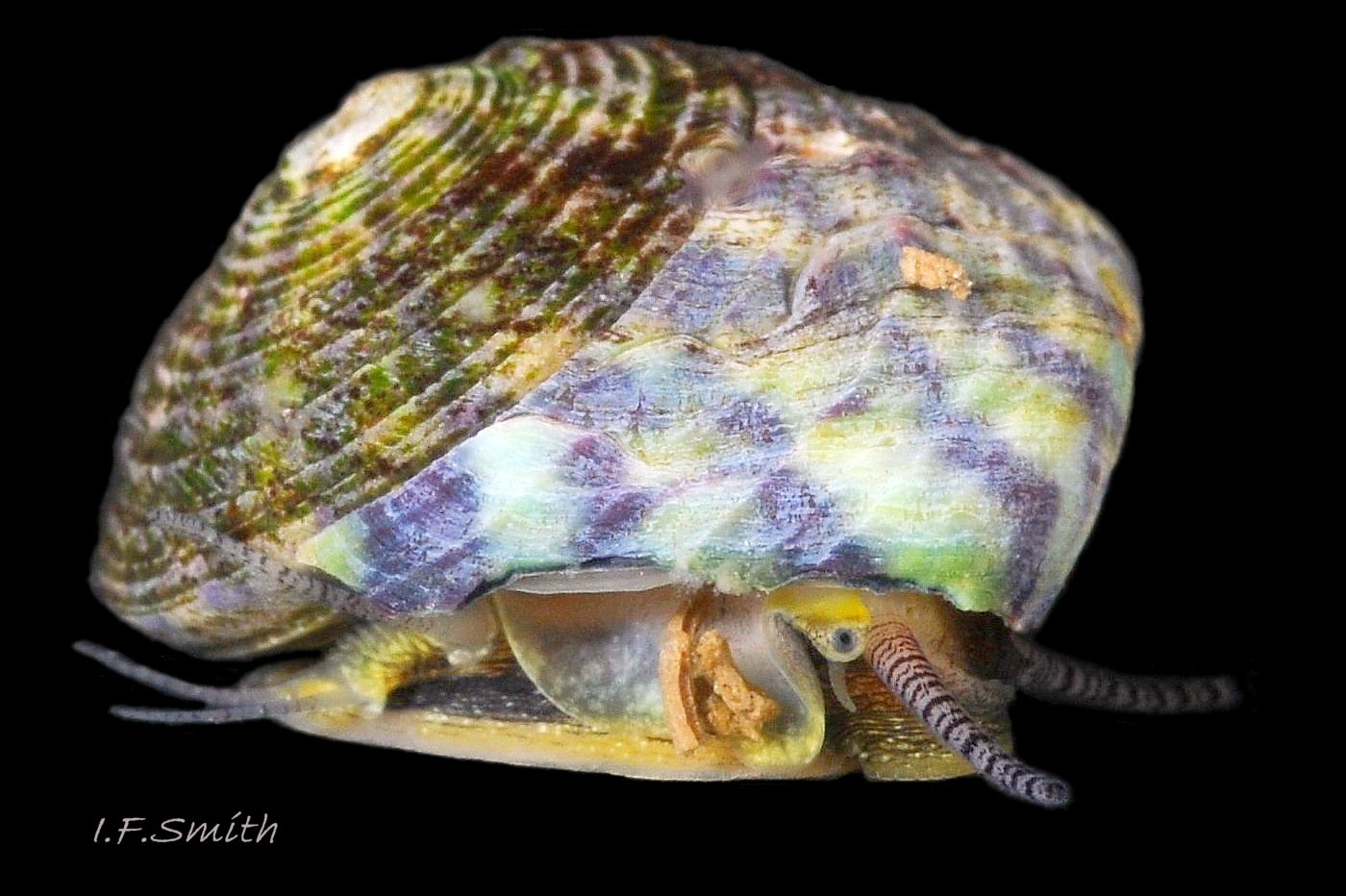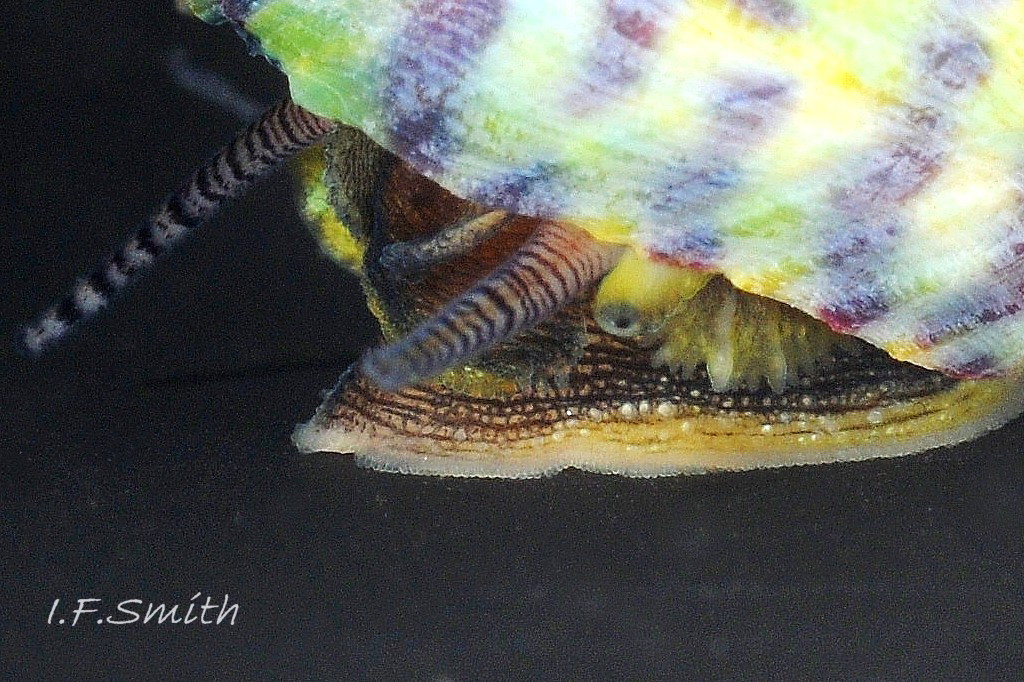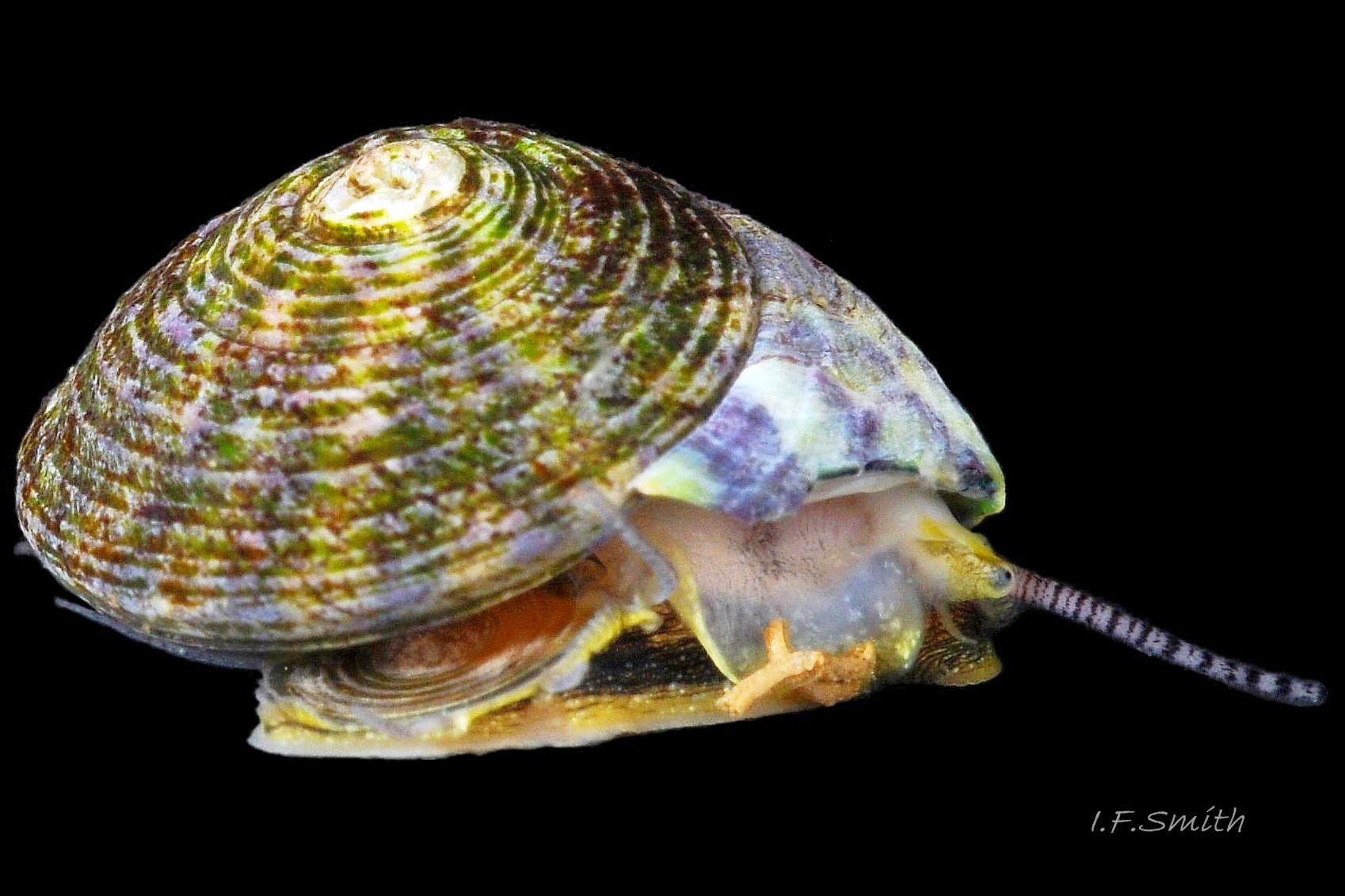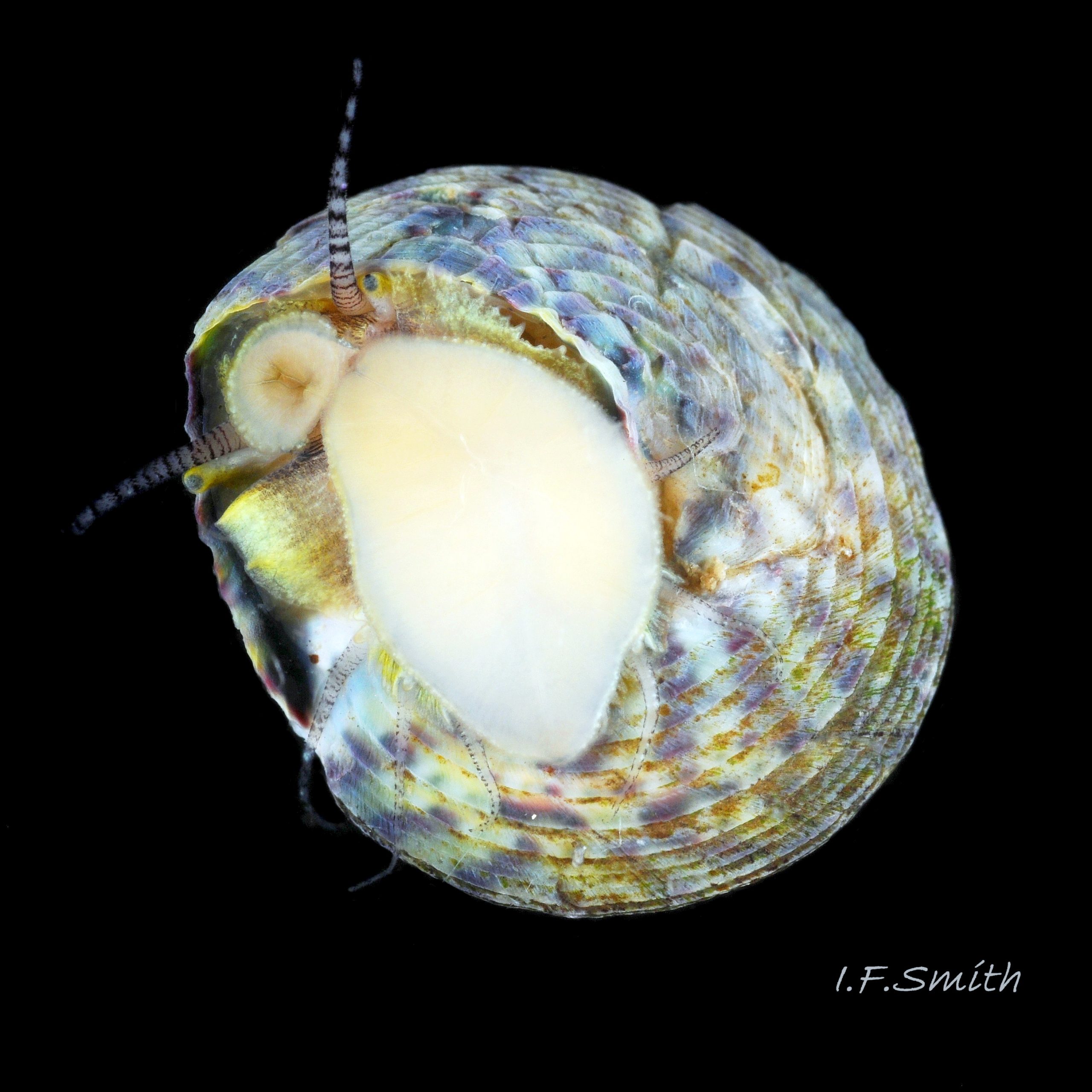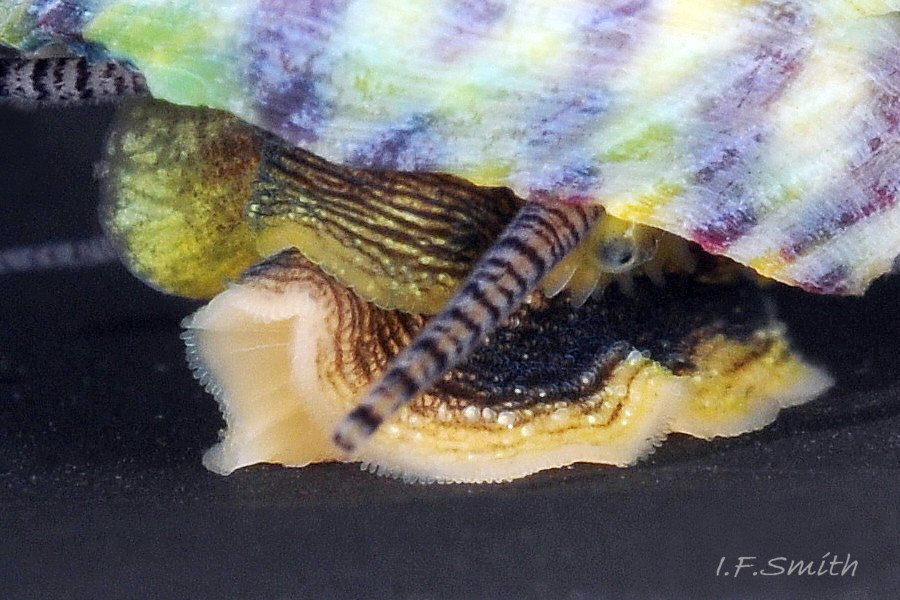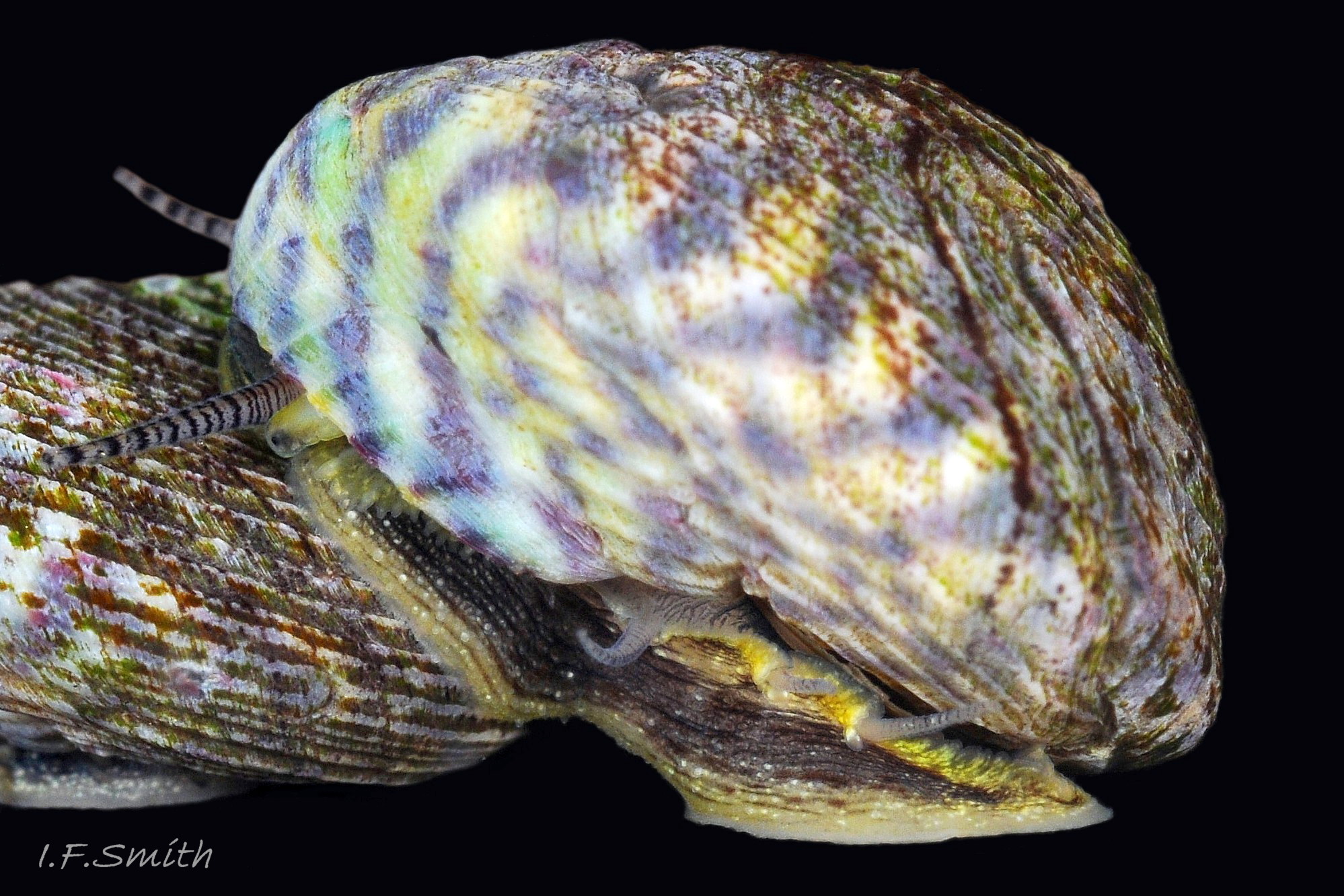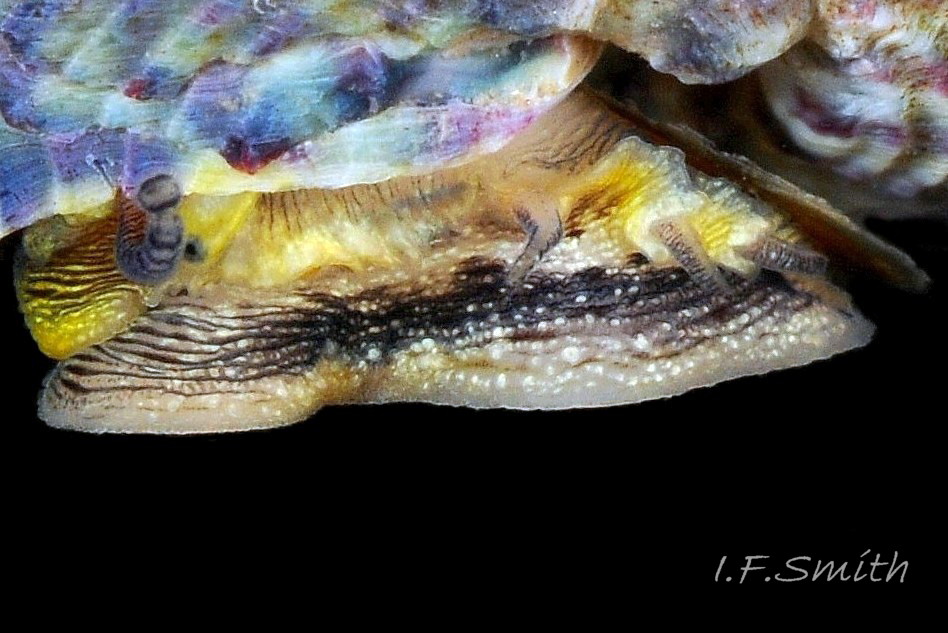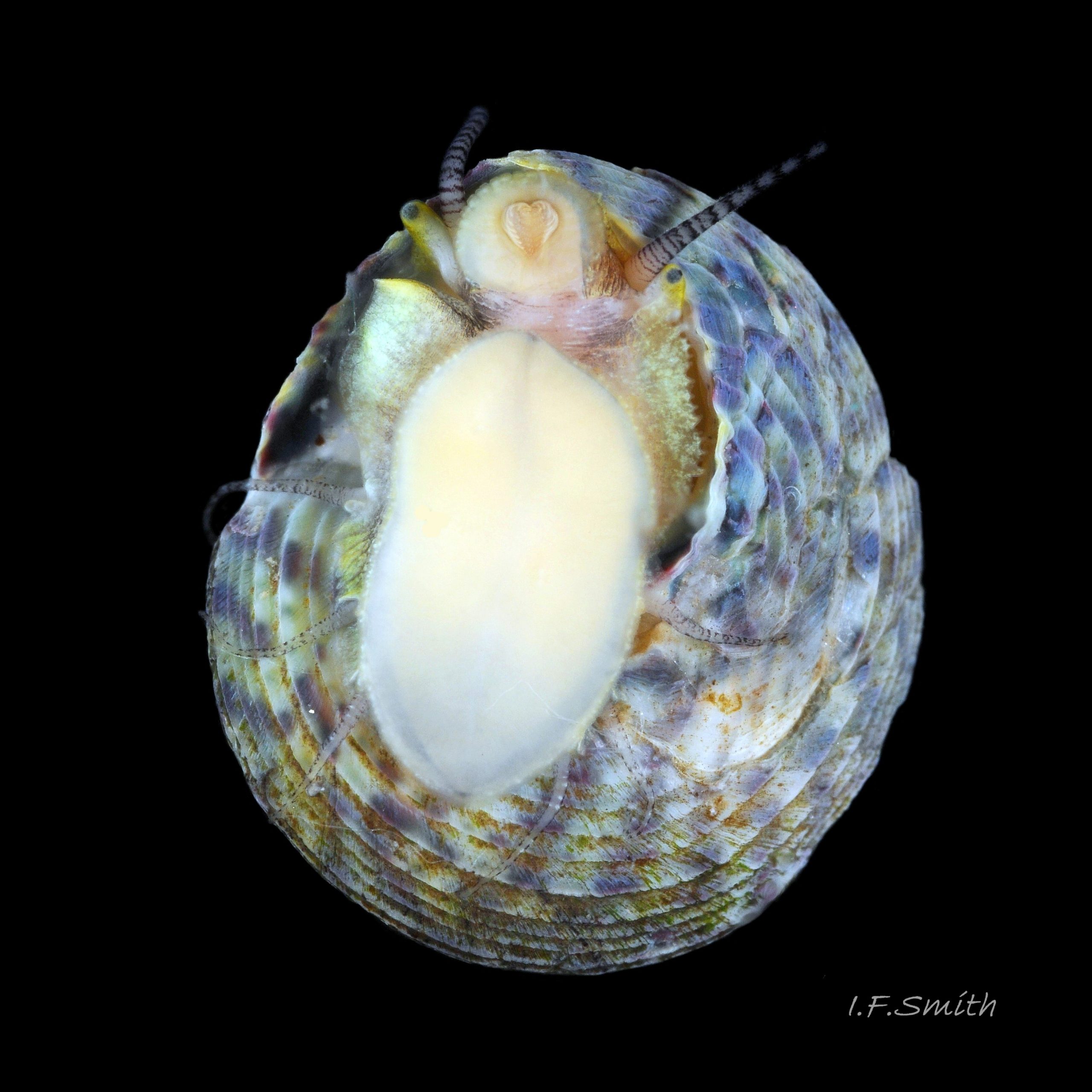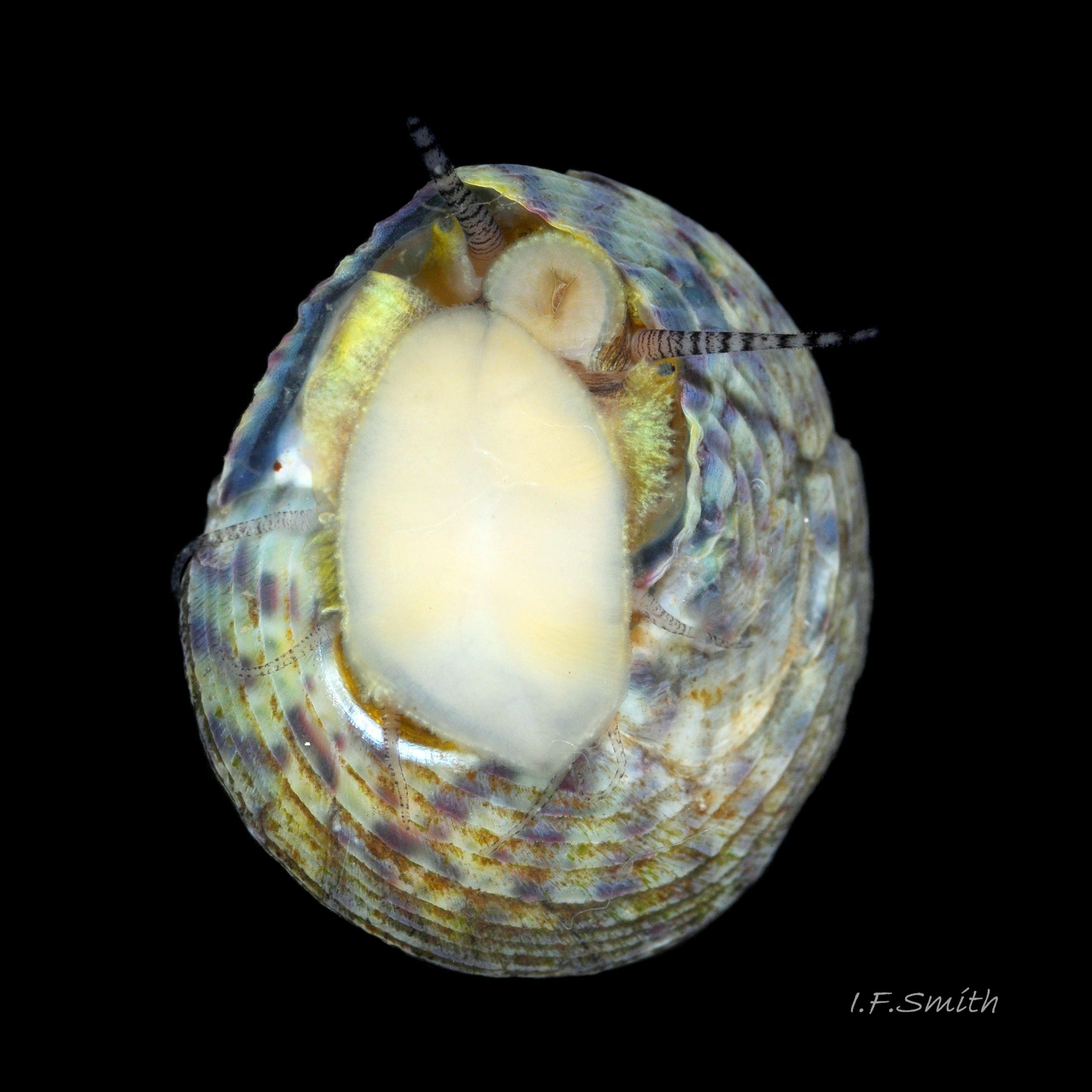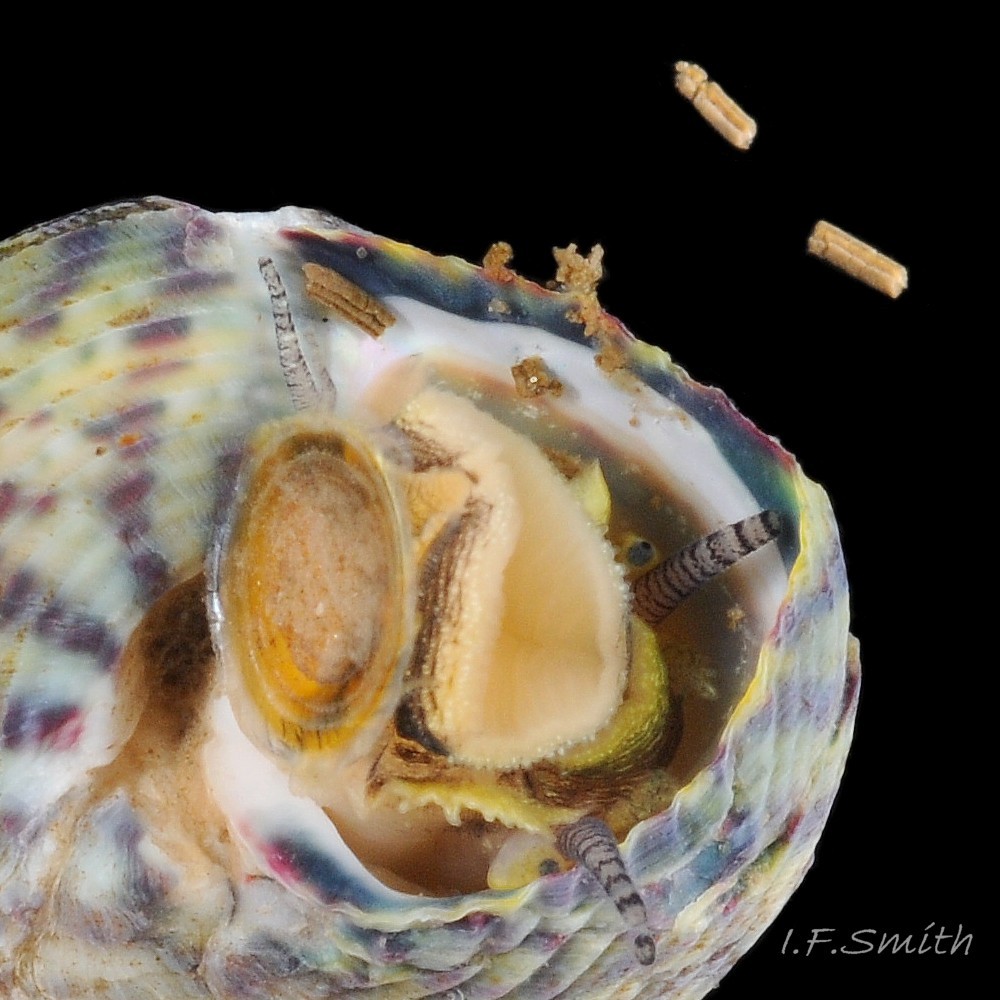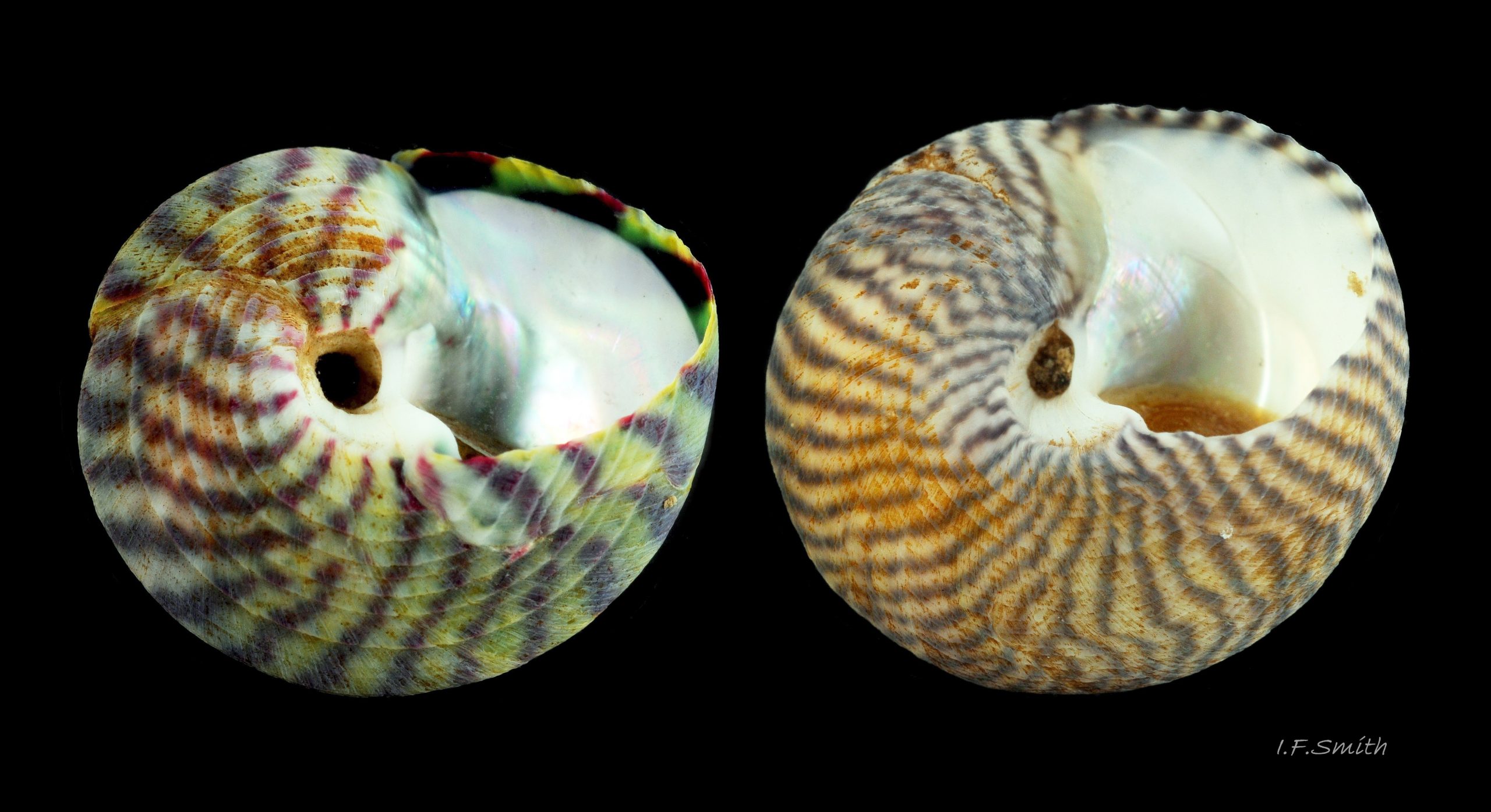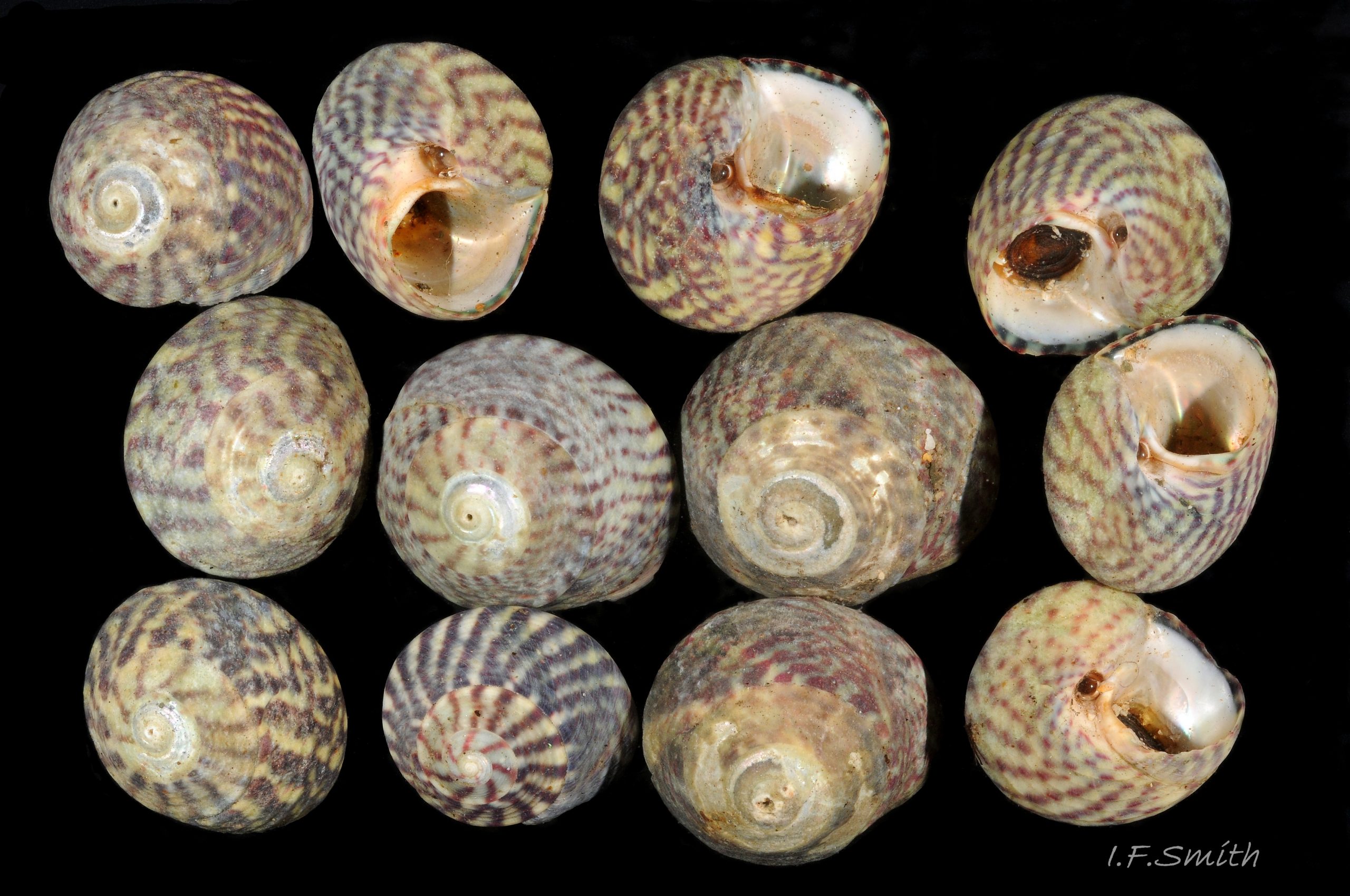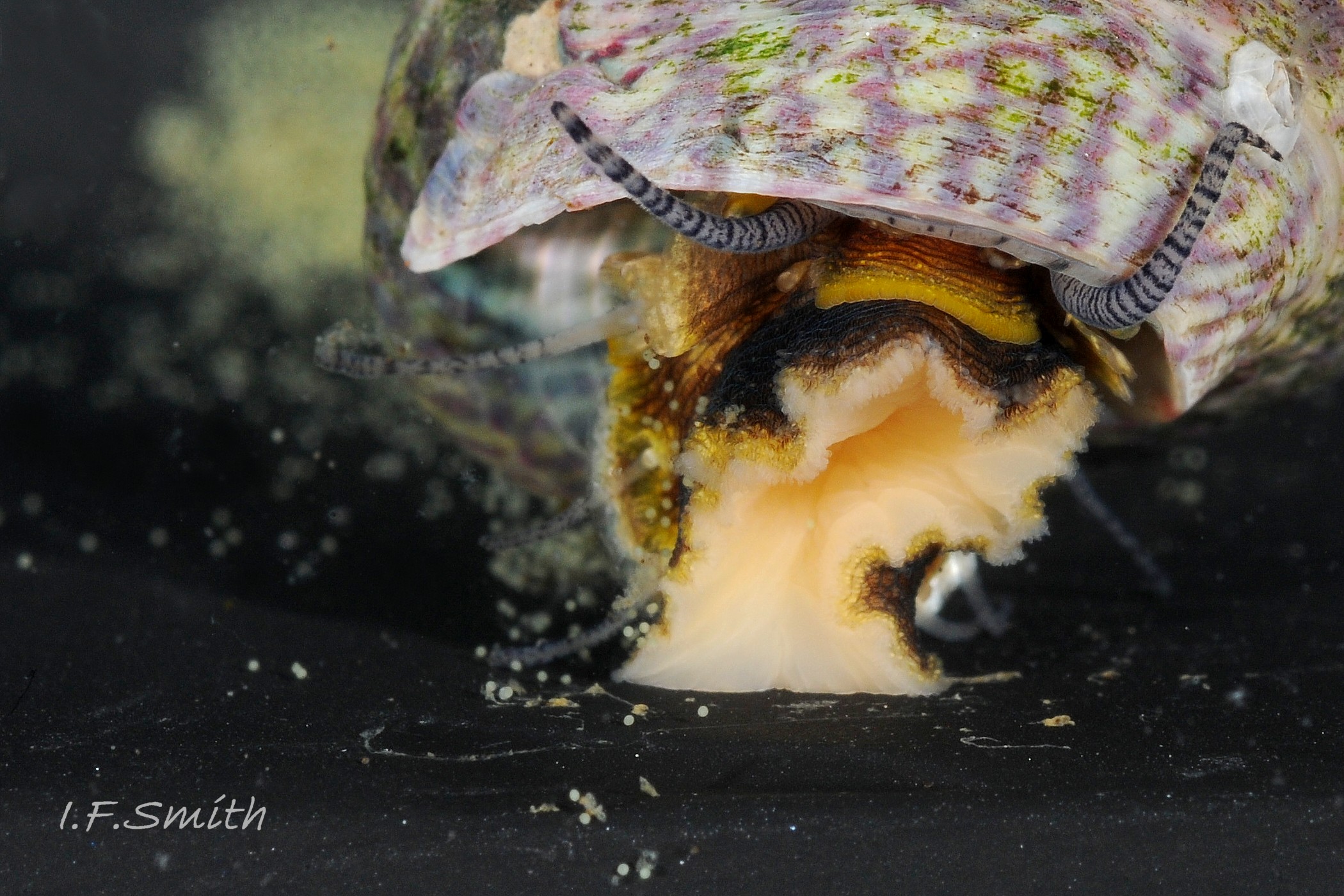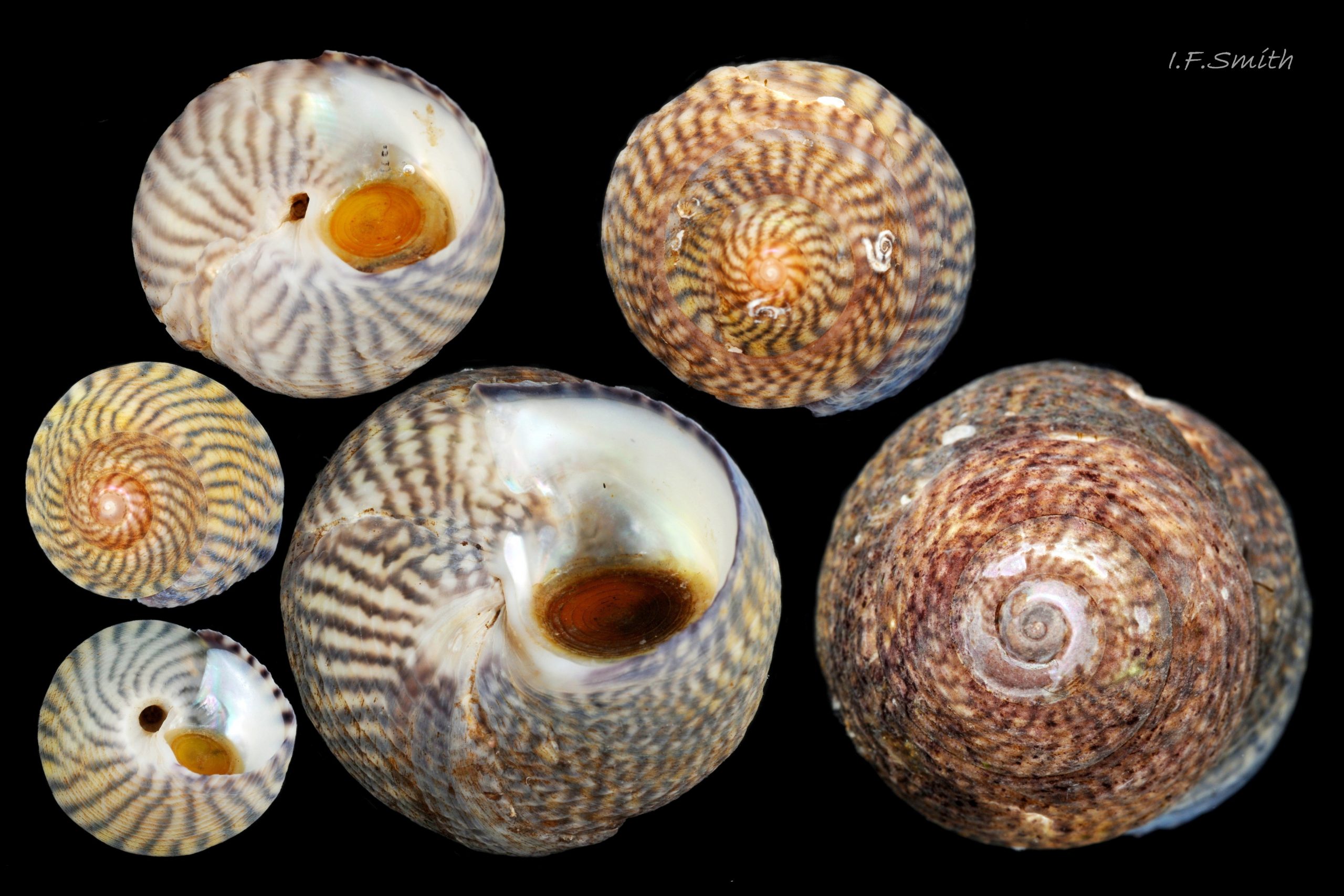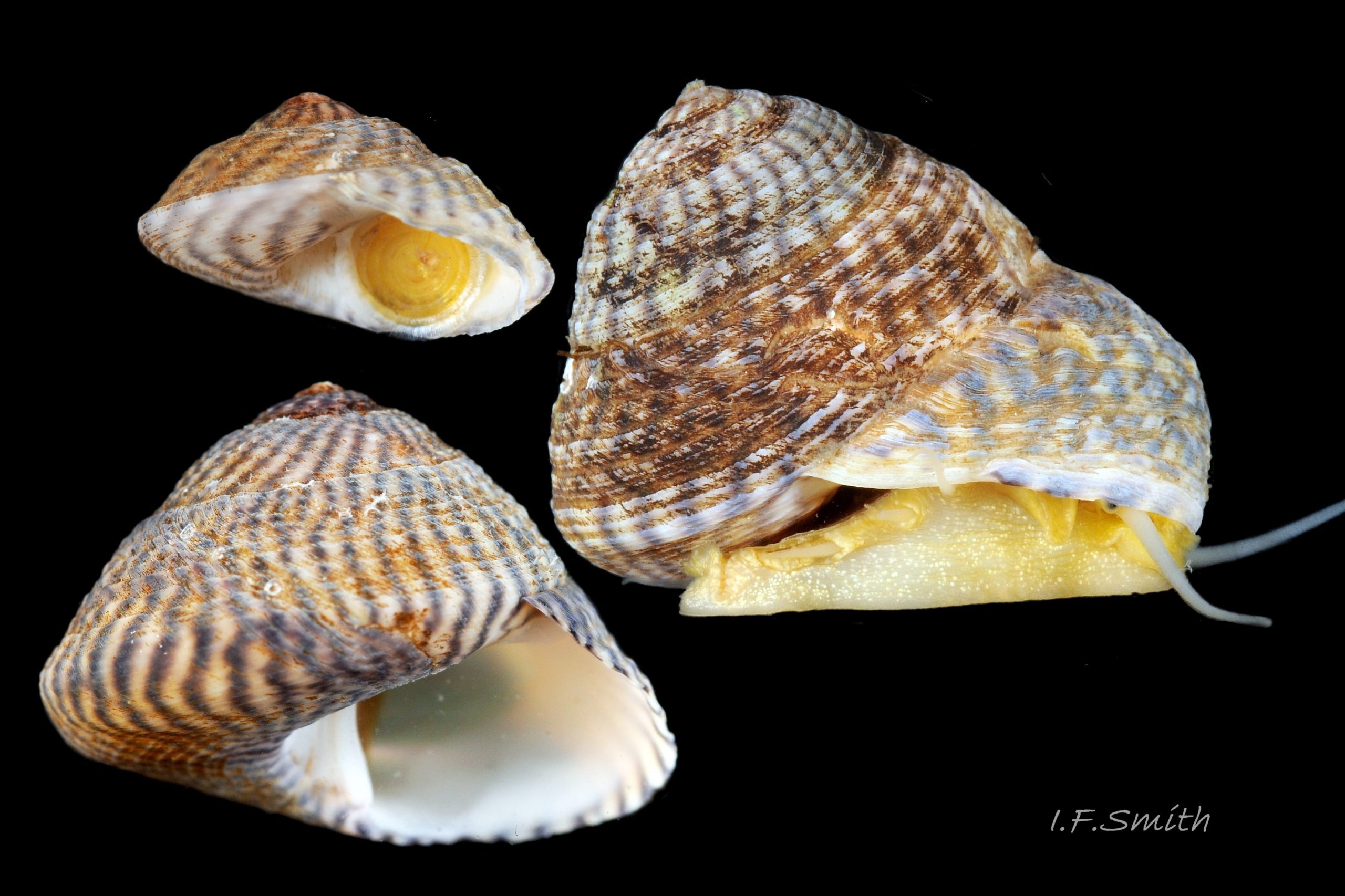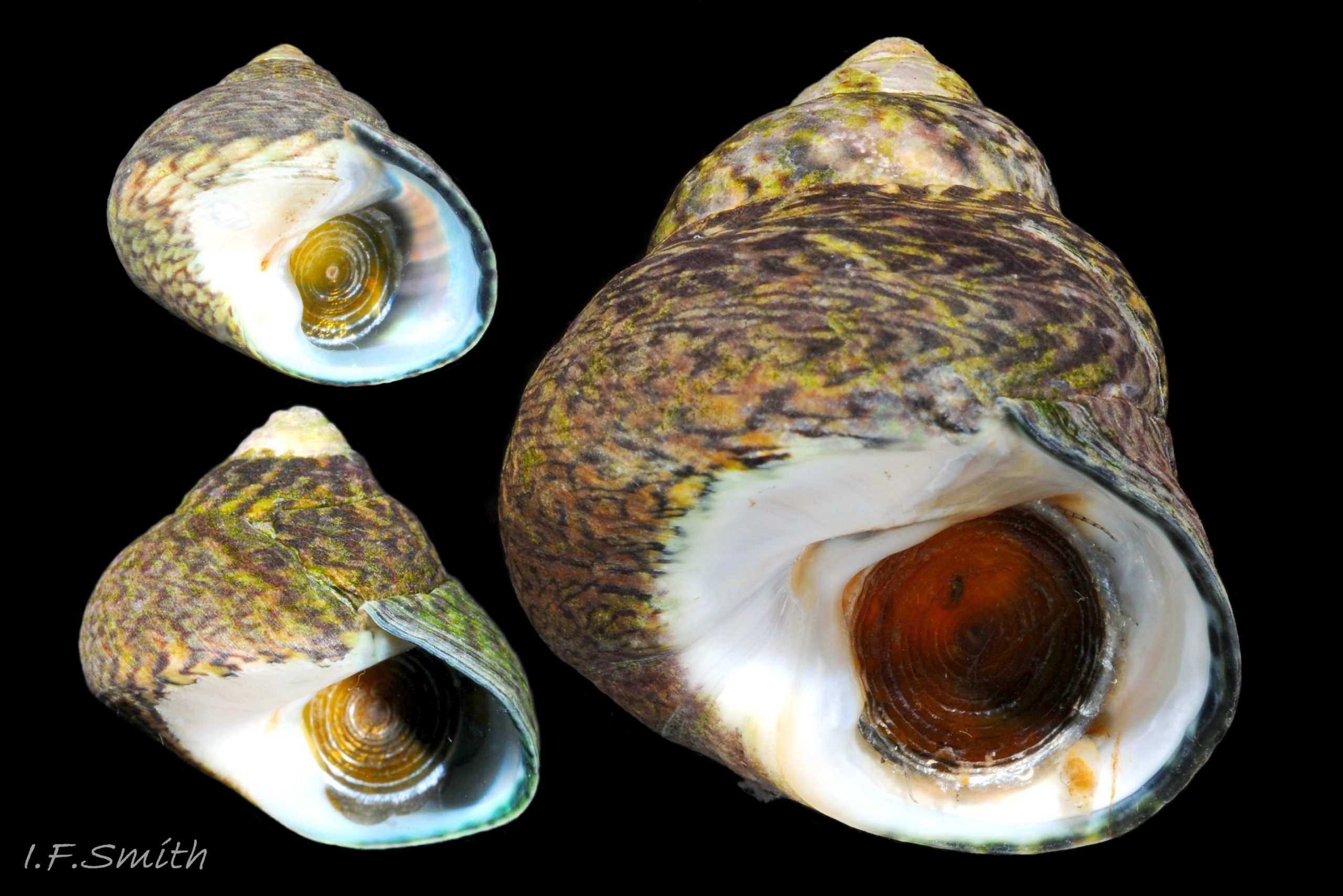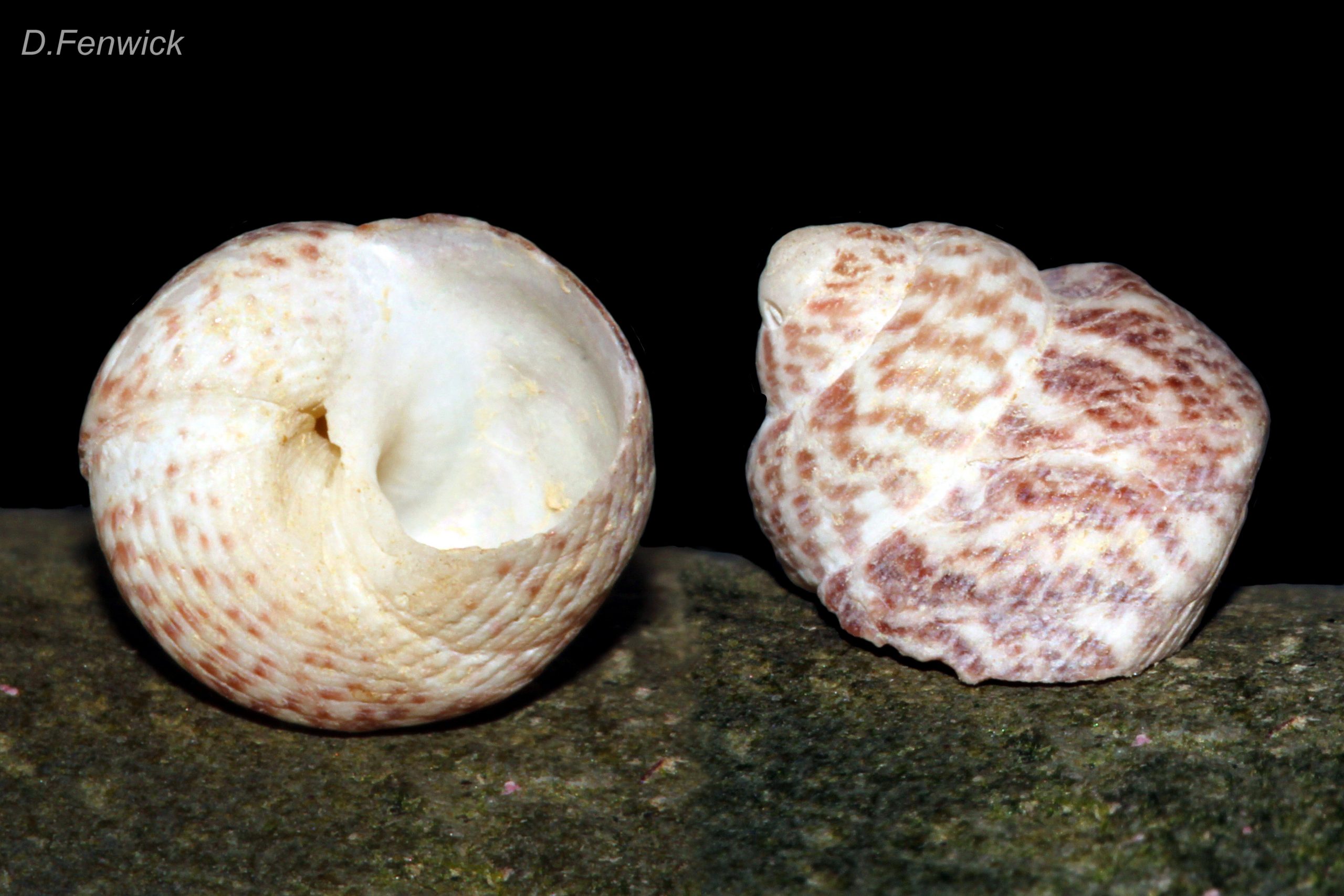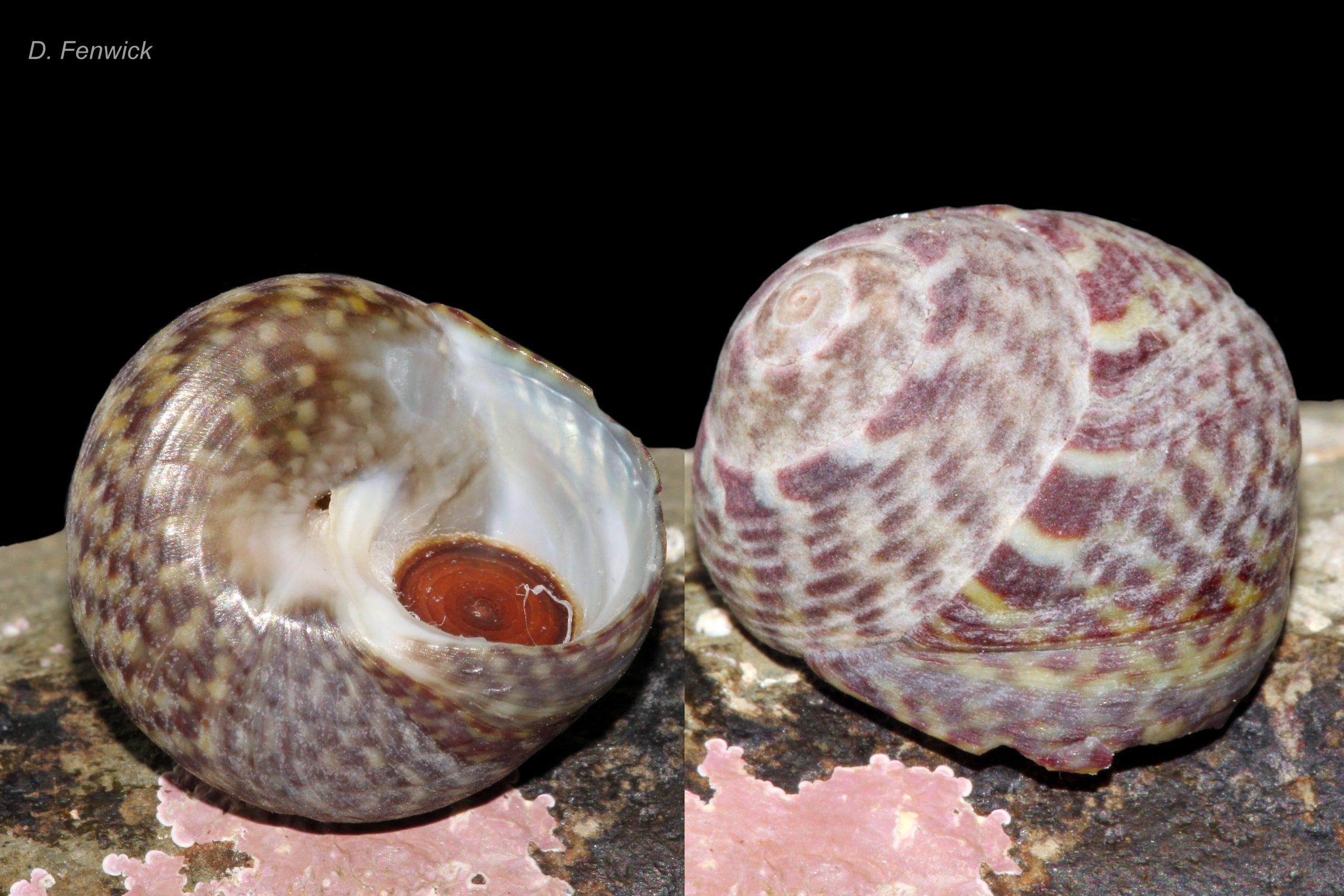Click image to enlarge with full caption. Main text below slider.
Steromphala umbilicalis (da Costa, 1778)
PDF available at www.researchgate.net/publication/349290429_Steromphala_um…
Account (2014) revised 2019, 2020 & 2022. Currently accepted name, Steromphala umbilicalis (da Costa, 1778) is used in revised parts. Unrevised text may retain old name, Gibbula umbilicalis.
Current taxonomy: World Register of Marine Species (WoRMS) www.marinespecies.org/aphia.php?p=taxdetails&id=141801 (The image of a Spanish shell on this web page is very unlike British G. umbilicalis.)
Synonyms: Trochus umbilicalis Da Costa, 1778; Trochus umbilicatus Montagu, 1803 in Jeffreys, and Forbes & Hanley; Gibbula umbilicalis (da Costa, 1778) until recently.
Vernacular: Flat top shell, Purple top shell, Top môr porffor (Welsh), Genavelde tolhoren (Dutch), Troque ombliqué gibbule (French).
*GLOSSARY below.
Description
Note, this description applies to specimens from Britain. Further south there are more similar species, and the features found on S. umbilicalis specimens may differ from those in Britain.
Shell
Breadth to 22mm, height to 16mm. Conoidal; height frequently about 60% of breadth 01 Steromphala umbilicalis., but varies about 45% to 85% 02 Steromphala umbilicalis . Sutures distinct. Spire small, body whorl about 80% of height 02 Steromphala umbilicalis . Small blunt apex, often eroded exposing silver nacre layer, and sometimes exposing upper end of hollow columella 29 Steromphala umbilicalis. Up to 11 raised spiral lines on body whorl below angulated periphery i.e. on base of shell 04 Steromphala umbilicalis . Large round white-bordered umbilicus always present 04 Steromphala umbilicalis . Aperture approximately semi-circular, about 60% of height 02 Steromphala umbilicalis ; parietal lip reflected as a glaze onto body whorl 04 Steromphala umbilicalis ; white columellar lip adjoining umbilicus; adapical angle about a right angle 02 Steromphala umbilicalis . Interior of shell thickened by shiny silvery white layers of aragonite crystals (nacre), apart from border just within outer lip coloured as exterior of shell 04 Steromphala umbilicalis .
Ground colour of shell whitish, often partly greenish or stained brownish by environmental factors 05 Gibbula umbilicalis. ,opaque, almost lustreless. Broad, slightly wavy, transverse, red to purple bands radiate from apex across the whorls when viewed dorsally, increasing in number on each subsequent whorl. Width of gaps between bands changes little as shell grows 05 Gibbula umbilicalis. . Protoconch (first two turns of spire) cream and unbanded 03 Steromphala umbilicalis but often stained or eroded on older shells. Beach-worn shells with nacre layer exposed by erosion share with other top shells the vernacular name “Silver tommy” flic.kr/p/d3BfZw ( image by Cat Walden) . Circular spiral operculum with many narrow coils , transparent horn colour, on withdrawn animal shows pale opercular disc and blackish flesh 06 Steromphala umbilicalis. .
Body
Ground colour of flesh yellowish or greenish, often heavily marked black-purple on adults, but early juveniles lack dark pigment 07 Steromphala umbilicalisSnout short, yellowish or greenish with dense transverse dark purple lines 9Su 09 Steromphala umbilicalis , except pinkish ventral surface 08 Steromphala umbilicalis . Dorsum of snout has pair of yellow, white and grey crenate cephalic lobes; transverse when snout contracted 09 Steromphala umbilicalis , longitudinal when snout extended 10 Steromphala umbilicalis. Dorsal and lateral rim of snout tip is circular and crenate 08 Steromphala umbilicalis . Mouth a vertical slit, with diagonal extensions at each end demarcating dorsal, ventral and lateral lips 11 Steromphala umbilicalis. Mouth. . Ventral lip has median line 12 Steromphala umbilicalis. (with a short projection reported by Fretter & Graham, but not visible in this set of images). Radula appears as soon as mouth starts to open 12 Steromphala umbilicalis and long marginal teeth fan out widely 13 Steromphala umbilicalis as they and odontophore with erect, scraping lateral teeth press onto substrate to brush up food particles. Marginal teeth curl back to pull particles into mouth as radula retracts 10 Steromphala umbilicalis. Cephalic tentacles long, densely setose 14 Steromphala umbilicalis, whitish, tinted pale purple basally, with encircling black-purple rings 09 Steromphala umbilicalis . Eye on stout yellowish or greenish peduncle at base of each cephalic tentacle 14 Steromphala umbilicalis; small black “pupil” exposed, surrounded by grey ring of rest of eye showing through translucent peduncle 12 Steromphala umbilicalis. Sensory tentacle at base of right eye peduncle 15 Steromphala umbilicalis (none on left). Large neck-lobe (lappet) behind each eye; translucent white and yellow (sometimes greenish) with fine dark purple freckling in parts; left one strongly fringed 16 Steromphala umbilicalis; right one, sub-rectangular with smooth edges, guides voided faeces away from mantle cavity containing ctenidium 17 Steromphala umbilicalis, curled at edge 15 Steromphala umbilicalis or curved to form exhalent respiratory siphon 18 Steromphala umbilicalis. Dorsal surface of foot densely covered in tubercles arranged in rows parallel to perimeter 19 Steromphala umbilicalis, ground colour yellowish mostly covered with dense brown or dark purple except peripherally. Well developed epipodium, greyish dorsally and yellowish or greenish ventrally, runs along each side of foot 20 Steromphala umbilicalis ; bears three white, transversely lined with dark purple, setose epipodial tentacles arising from white jagged sheath bearing a tubercle 21 Steromphala umbilicalis; Opercular disc not expanded into lobe enclosing any of operculum edge 21 Steromphala umbilicalis , visible as pale patch through transparent operculum when animal retracted into shell 07 Steromphala umbilicalis. Sole tawny white, short, approximately oval, divided longitudinally by slight furrow 22 Steromphala umbilicalis, finely fringed periphery 19 Steromphala umbilicalis. Fertilization external, so no penis on males. Sometimes the comb-like ctenidium can be seen in the mantle cavity behind the head, and the pink internal buccal mass is visible inside the pigmentless body of juveniles 07 Steromphala umbilicalis .
Key identification features
The principal source of misidentification by both novice and experienced workers is that young small shells of S. cineraria, with low profile and relatively widely spaced bands, are mistaken for S. umbilicalis.
In a sample of 71 shells of S. umbilicalis and S. cineraria, collected from sites between north coast Scotland and south coast England, the average number of bands within each width category on S. cineraria was approximately double the average onS. umbilicalis, with no overlap in the ranges. Bands were counted around the periphery of the body whorl, including part of the outer lip to complete the circuit. Examples:
Width 14 mm to 15.9mm
S. umbilicalis mean 22 bands (range 18 –31 bands).
S. cineraria mean 52 bands (range 35 –68 bands).
Width 12mm to 12.9mm 25 Comparison of S. umbilicalis and S. cineraria
S. umbilicalis mean 17 bands (range 13 –23 bands).
S. cineraria mean 41 bands (range 34 –49 bands).
Width 5mm to 8.9mm 26 Comparison small S. umbilicalis and S. cineraria.
S. umbilicalis mean 10 bands (range 7 –13 bands).
S. cineraria mean 25 bands (range 19 –29 bands).
Steromphala umbilicalis
1. Shell has broad red to reddish-purple bands radiating from apex across the whorls 05 Gibbula umbilicalis. . Maximum shell width 22mm.
2. Number of bands within each width category is approximately half the average found on S. cineraria, with no overlap in the ranges. 25 Comparison S. umbilicalis and S. cineraria , 26 Comparison small S. umbilicalis and S. cineraria. and data above.
3. Bands on S. umbilicalis are wider than those on G. cineraria.
4. Shell always has a large round umbilicus 04 Steromphala umbilicalis .
5. Shell profile usually low, but variable 02 Steromphala umbilicalis
6. In Britain, adults found littorally, but not living sublittorally, from Kent along south and up west coasts round to Loch Eriboll 28 Steromphala umbilicalis on north coast Scotland, with a few records on west coast of Orkney (recent move eastwards in the islands). NBN records in North Sea, especially divers’ records, are probably misidentifications of S. cineraria. It is advisable to keep live-taken specimens or clear photographs with scale/measurement (not estimate) to support any claimed S. umbilicalis record from this area; it may move into N. Sea with warmer winters.
Similar species
Steromphala cineraria
1. Narrow, greyish bands (bluish-purple-grey, brown-grey or dark brown-grey, but not reddish-purple) on yellowish or light grey ground colour radiate from apex of shell across the whorls. 31 Steromphala umbilicalis Maximum shell width 16mm.
2. Number of bands within each width category on S. cineraria is approximately double the average on S. umbilicalis, with no overlap in the ranges 25 Comparison of S. umbilicalis and S. cineraria , 26 Comparison small S. umbilicalis and S. cineraria. and data above.
3. Bands on S. cineraria are narrower than those on S. umbilicalis . But beware; bands on both species increase only slightly in width with shell growth, so they look proportionately wider on very small shells, leading sometimes to small S. cineraria being mistaken for S. umbilicalis because of “wide” bands 26 Comparison small S. umbilicalis and S. cineraria. .
4. Umbilicus progressively narrows with age 31 Steromphala umbilicalis. Adult shell may have very restricted or completely closed umbilicus, but juveniles may have large round umbilicus like that of S. umbilicalis 27 Comparison small G. umbilicalis and G. cineraria.
5. Shell profile higher than S. umbilicalis on average, but large overlap; only use profile to distinguish S. cineraria if shell like straw bee-hive (skep) with height over 86% of breadth 32 Steromphala umbilicalis.
6. Adults found littorally and sublittorally all round UK, including North Sea.
Phorcus lineatus (da Costa, 1778) [=Osilinus lineatus, Monodonta lineata].
1. Many short zig-zag streaks of brown, red, purple or green transversely across whorls, arranged into clear bands radiating from apex only on early whorls 33 Steromphala umbilicalis Beware small shells under 15mm width dominated by early whorls; in apical view can resemble S. umbilicalis of similar size 29 Steromphala umbilicalis
Maximum width 25mm, height 30mm.
4. Umbilicus open on juveniles up to 5mm high, larger shells usually have umbilicus covered by inner lip of aperture folded over it, leaving an umbilical depression and occasionally a minute hole. Rounded tooth on columella.
5. Shells up to about 16mm height have moderately low profile; larger ones can be very tall.
6. Adults live near high water mark in SW Britain from Isle of Wight to Anglesey, and around most of Ireland except part of east coast.
Steromphala tumida (Montagu, 1803)
34 Steromphala umbilicalis
1. Brownish bands and/or spots. Maximum shell width 10mm.
4. Comma shaped umbilicus narrows and closes with age.
5. Sharply pointed cone with stepped profile and flat body whorl..
6. Most British coasts, usually sublittoral, rarely live on shore, but dead shells sometimes on strandline. Iceland to Spain.
Steromphala pennanti (Philippi,1851)
35 Steromphala umbilicalis
1. Shell colour and banding very similar to S. umbilicalis, but bands tend to break into chequers on base and sometimes on rest of shell.
4. Small constricted umbilicus on juveniles, closed on full grown adults.
6. Littoral and sublittoral, Channel Islands and Cherbourg to Spain; not British mainland.
Habits and ecology
On brown fucoid seaweeds or under stones, even if devoid of fucoids, on rocky shores MHWN to MLWS. Not often sublittoral; distribution controlled by winter air temperature (not below about 4.4°C Feb. mean) and/or surface water temperature (not below about 6°C Feb mean). Also in rock pools, extending above MHWN. Cilia on fringed left neck-lobe wave to create inhalent current to ctenidium within mantle cavity 16 Steromphala umbilicalis. Cilia on smooth edged right neck-lobe create exhalent current for respiratory water 18 Steromphala umbilicalis, ova or sperm 30 Steromphala umbilicalis, and excreta 17 Steromphala umbilicalis.. Locomotion is enabled by direct, ditaxic waves on the sole of the foot 23 Steromphala umbilicalis; turning is caused by different rates of wave flow on either side of the central furrow, or even reversal of direction to retrograde on one side. Feeds on brushings from seaweeds and on algal debris. Faecal string from stomach has U shape cross-section; thinner cylindrical string from kidney is deposited along the groove of U and is seen in excreted string 24 Steromphala umbilicalis. Spawning triggered by rise in temperature; dates vary within period May-September at different locations. External fertilization occurs as non-buoyant yellowish-green ova released singly via right neck-lobe from mantle cavity 30 Steromphala umbilicalis . Ova hatch as trochophore larvae, which quickly metamorphose into veliger larvae that semi swim/crawl on or near bottom. As little or no planktonic phase, distant transport will be a rare occurrence, and remote establishment of reproducing population unlikely as external fertilization requires dense population for success.
Distribution and status
Gibraltar to west coast of Orkney, (Not North Sea, N.E. Irish Sea or Baltic, all too cold; many erroneous records on GBIF and NBN) GBIF map www.gbif.org/species/9471950 . U.K. map NBN species.nbnatlas.org/species/NHMSYS0021185570
IMPORTANT! Many records marked on the NBN map for North Sea are ‘ABSENCE records’, without proof otherwise, other N. Sea records should be regarded as misidentifications . S. umbilicalis is used as a text book example of temperature control of distribution (Lewis, J. R., 1964). It is important that the distribution is not confused by inaccurate identification, and that any range extension because of climate warming is reliably documented.
Edit, June 2022: with recent increases in sea temperature there has been a range expansion into the south of the North Sea which has reached north of the Thames Estuary (2022, S. Taylor, pers. comm.).
Acknowledgements
I thank Peter Topley for helpful I.T. advice, and I am grateful to David Fenwick www.aphotomarine.com/index.html for use of two of his images for the Similar Species section.
Links and references
Crothers, J.H. 2001. Common topshells: an introduction to the biology of Osilinus lineatus with notes on other species in the genus. Field studies, 10, 115-160.
(Free pdf at fsj.field-studies-council.org/media/342011/vol10.1_265.pdf )
Forbes, E. & Hanley S. 1849-53. A history of the British mollusca and their shells. vol. 2 (1849), London, van Voorst. (As Trochus umbilicatus; Free pdf at archive.org/details/historyofbritish02forb/page/518 Use slide at base of page to select pp.519-522.) (Error on plate DD, vol. 1, of G. cineraria, acknowledged in text, shows both neck lobes fringed; right one should have smooth edge.)
Fretter, V. and Graham, A. 1962. British prosobranch molluscs. London, Ray Society.
Graham, A. 1988. Prosobranch and pyramidellid gastropods. London. (Error in description states “Animal like G. cineraria but cephalic lappets and left neck lobe have smooth edges.” : both species have fringed edges on cephalic lappets (lobes) and left-neck lobe, and smooth edges on the right neck-lobe.)
Jeffreys, J.G. 1862-69. British conchology. vol. 3 (1865). London, van Voorst. (As Trochus umbilicatus; Free pdf at archive.org/details/britishconcholog03jeffr . Use slide at base of page to select pp.312- 315.)
Lewis, J.R. 1964. The ecology of rocky shores. London, Hodder & Stoughton.
Current taxonomy: World Register of Marine Species (WoRMS) www.marinespecies.org/aphia.php?p=taxdetails&id=141801 (The image of a Spanish shell on this web page is very unlike British G. umbilicalis.)
Glossary
adapical – towards the apex of the shell.
aperture – mouth of gastropod shell; outlet for head and foot.
bifid – divided into two parts by a cleft.
cephalic – (adj.) of or on the head.
cilia – (pl.) vibrating linear extensions of membrane used in feeding or locomotion. (“cilium” singular).
ciliated – (adj.) coated with cilia.
columella – solid or hollow axial “little column” around which gastropod shell spirals; hidden inside shell, except on final whorl next to lower part of inner lip of aperture where hollow ones may end in an umbilicus or siphonal canal.
columellar – (adj.) of or near central axis of spiral gastropod.
columellar lip – lower (abapical) part of inner lip of aperture.
conoidal – nearly conical
diatom – microscopic aquatic alga with siliceous cell-walls.
conchiolin – horny flexible protein that forms the operculum of most marine gastropods, and a matrix for the deposition of calcium carbonate to create a mollusc’s shell.
ctenidium – comb-like molluscan gill; usually an axis with a row of filaments either side.
ditaxic – (of locomotion waves on foot) double series of waves, out of phase with each other, one series on each side of central furrow on sole.
direct – (of locomotion waves on foot) waves travel from posterior to anterior.
ELWS – extreme low water spring tide (usually near March and September equinoxes).
epipodial – (adj.) of the epipodium (collar or circlet running round sides of foot of some gastropods).
epipodium – collar or circlet running round sides of foot of some gastropods, often bearing epipodial tentacles.
everted – turned inside out.
height – (of gastropod shells) distance from apex of spire to base of aperture.
mantle – sheet of tissue that secretes the shell and forms a cavity for the gill in most marine molluscs.
odontophore – cartilaginous “tongue” that supports and protracts /retracts the radula.
opercular – (adj.) of the operculum.
opercular groove – groove across foot which produces conchiolin for creation of operculum to its posterior. Conchiolin produced faster at right end of groove so resultant ribbon curves to form spiral operculum.
opercular disc – part of foot that growing operculum rotates on.
opercular lobe – extension of opercular disc round edge of part of operculum.
operculum – plate of horny conchiolin, rarely calcareous, used to close shell aperture.
periostracum – thin horny layer of chitinous material often coating shells.
parietal lip – upper part of inner side of gastropod aperture.
plankton – animals and plants that drift in pelagic zone (main body of water).
retrograde – (of locomotion waves on foot) waves travel from anterior to posterior.
setose – bearing many setae.
seta – stiff hair or bristle. (pl. setae)
suture – groove or line where whorls of gastropod shell adjoin.
trochophore – spherical or pear-shaped larvae that swim with aid of girdle of cilia. Stage preceding veliger, passed within gastropod egg in most spp. but free in plankton for limpets, Trochidae and Tricolia pullus.
umbilicus – cavity up axis of some gastropods, open as a hole or chink on base of shell, often sealed over.
veliger – shelled larva of marine gastropod or bivalve mollusc which swims by beating cilia of a velum (bilobed flap).
